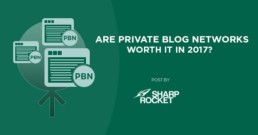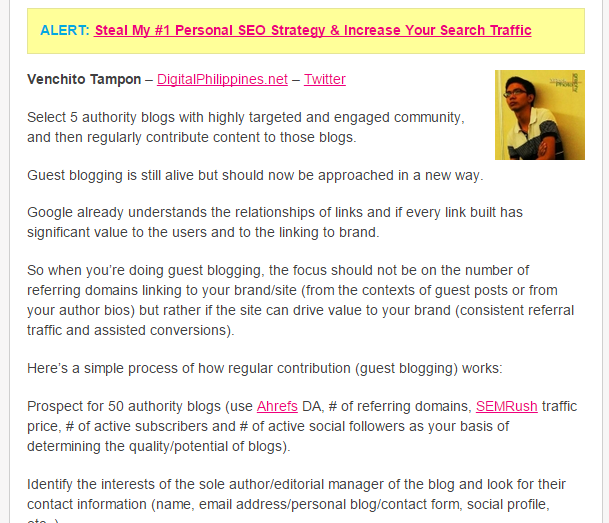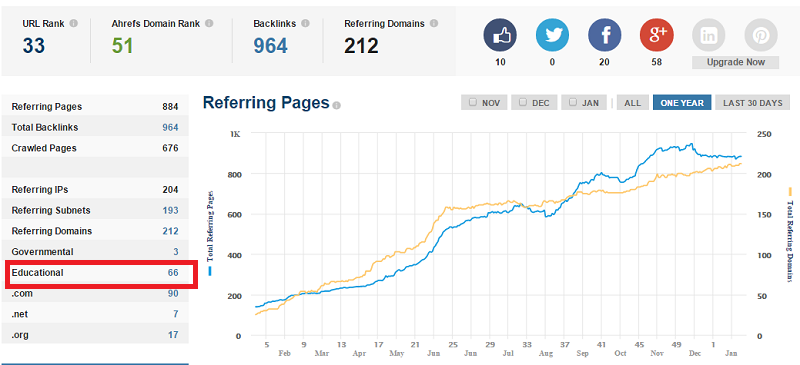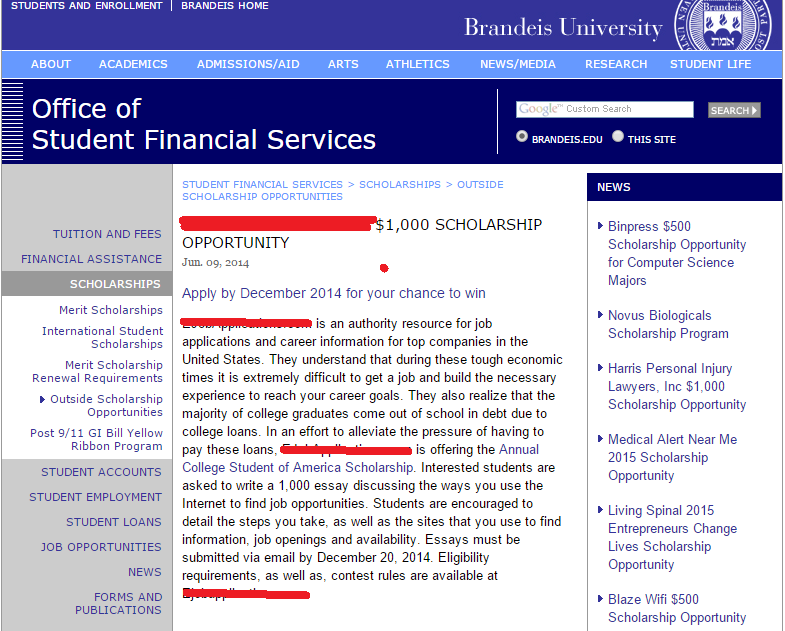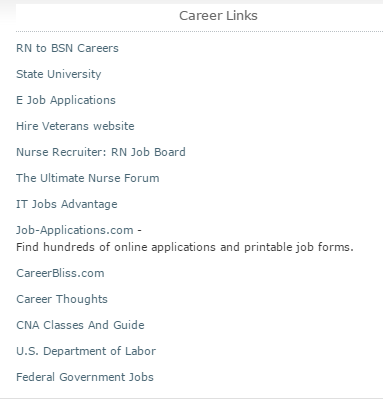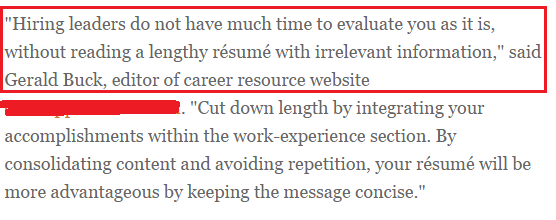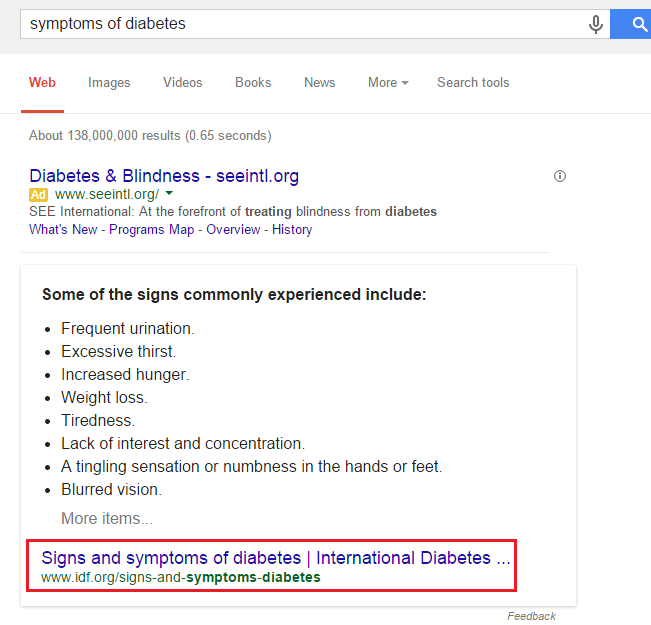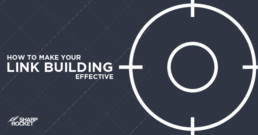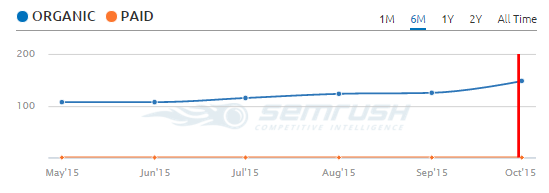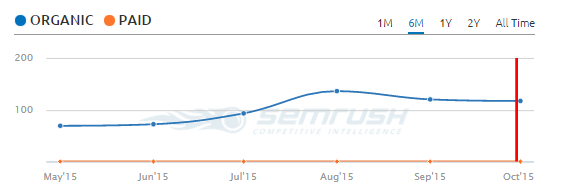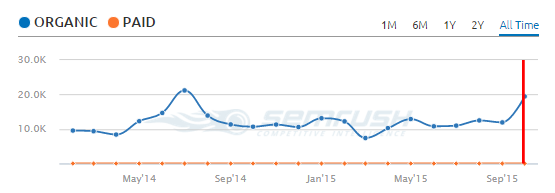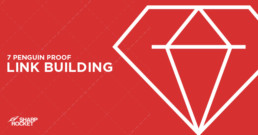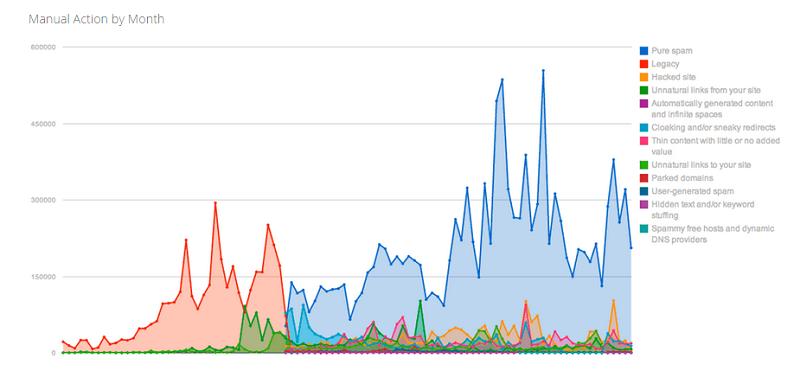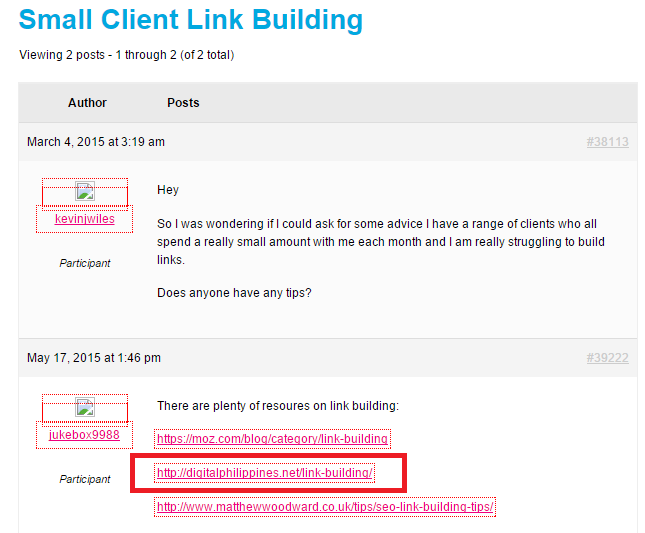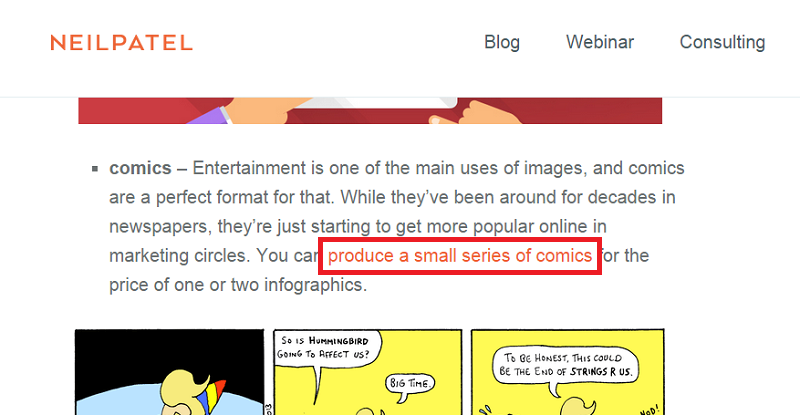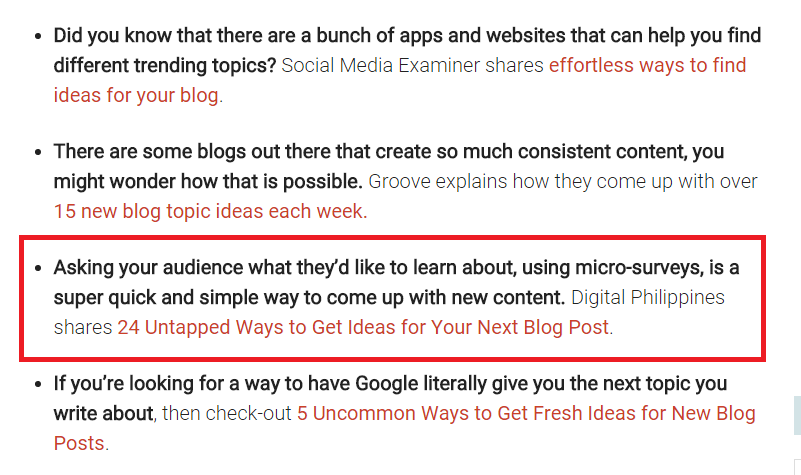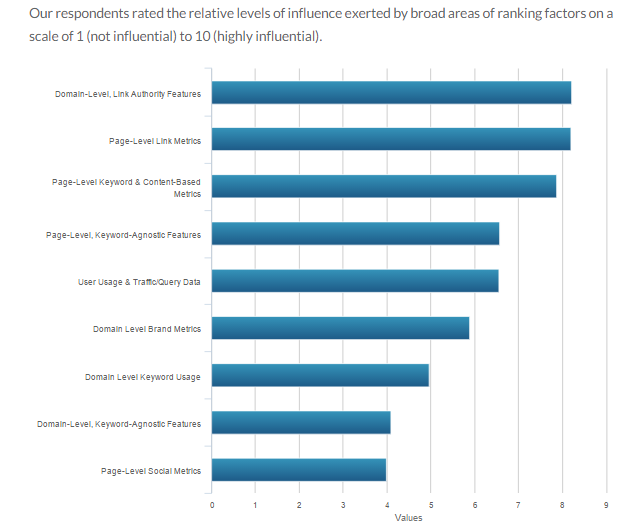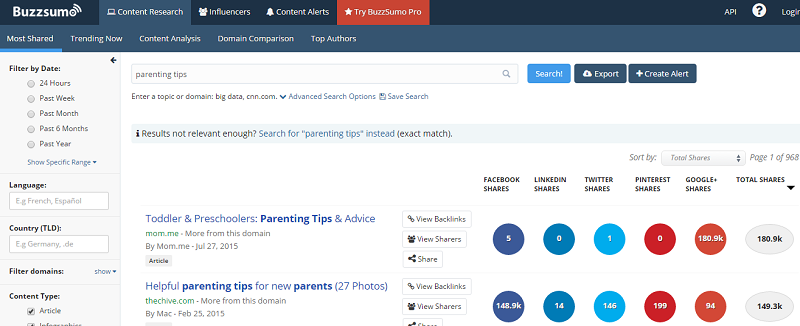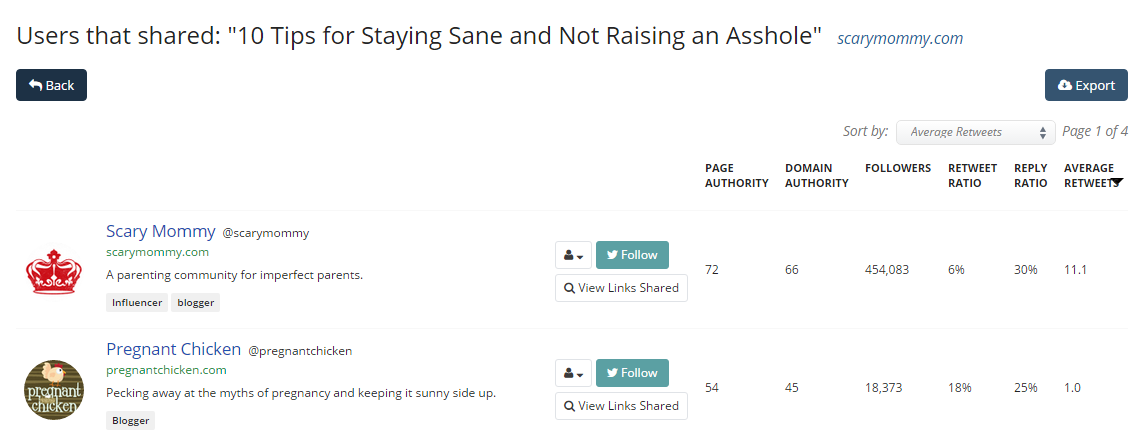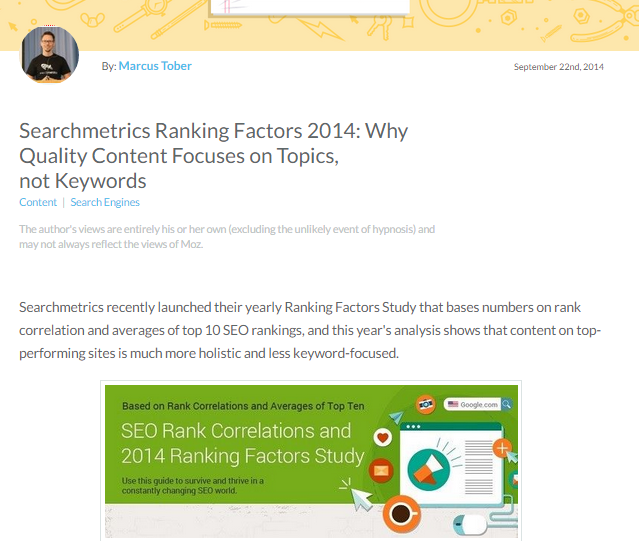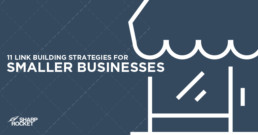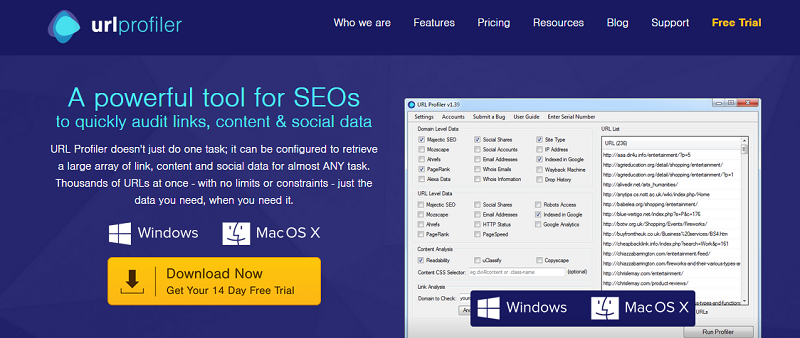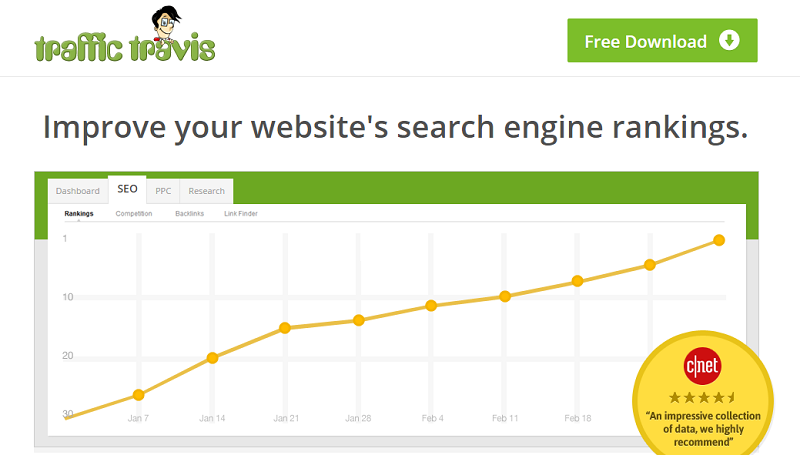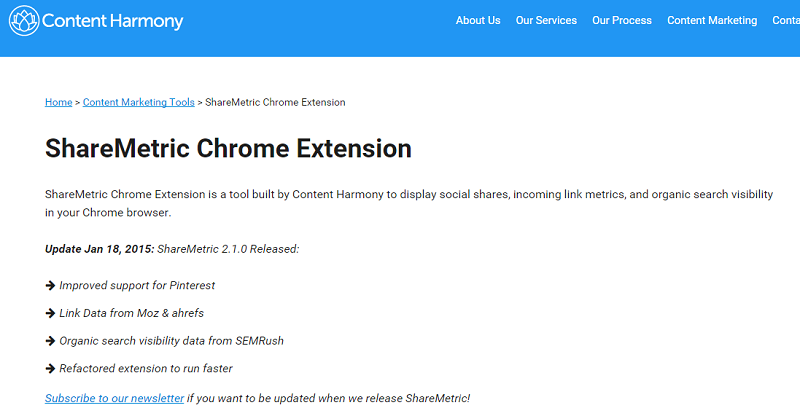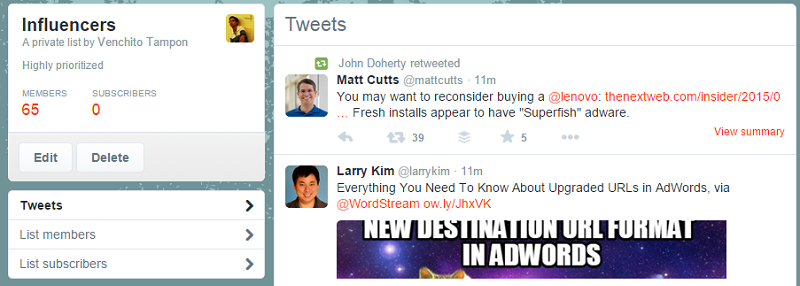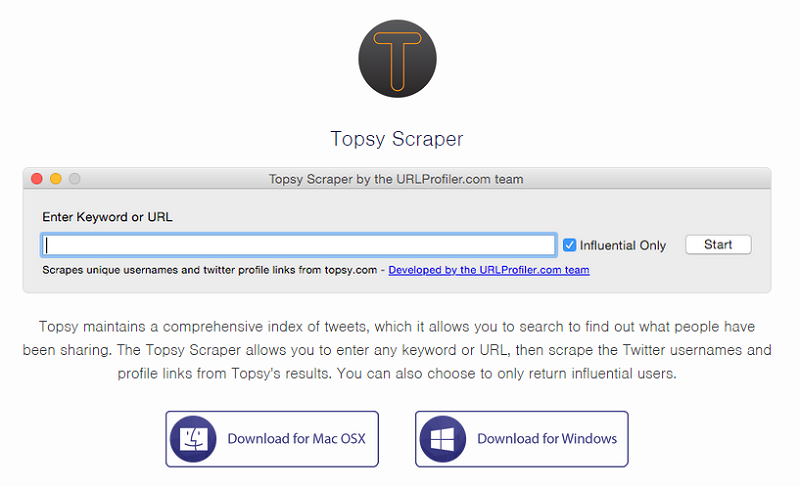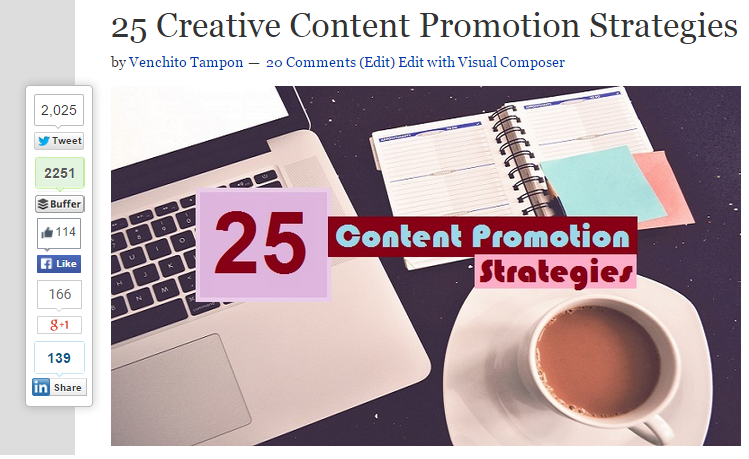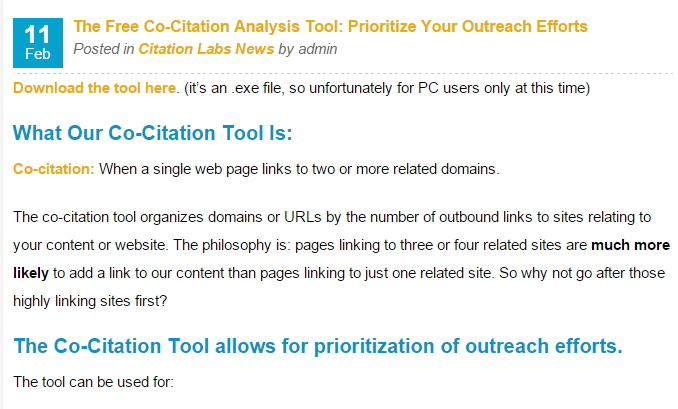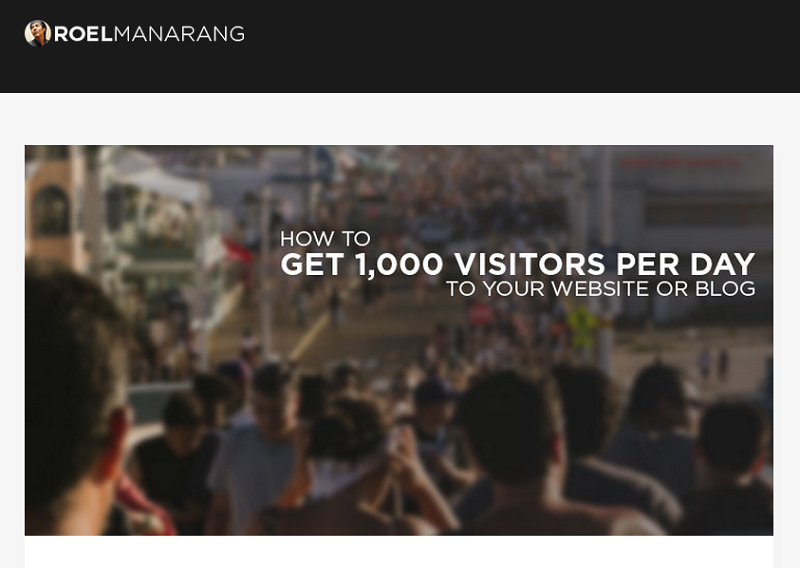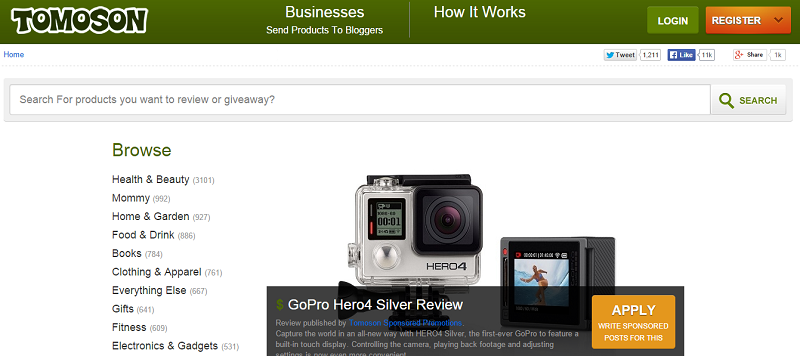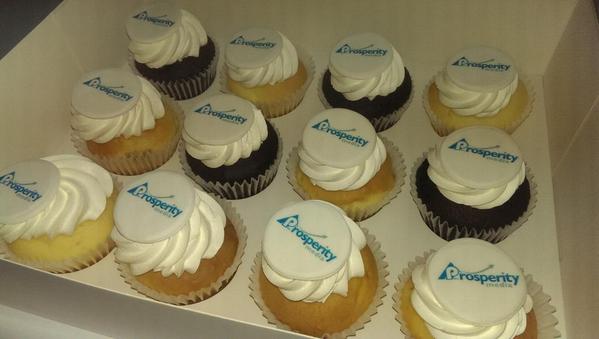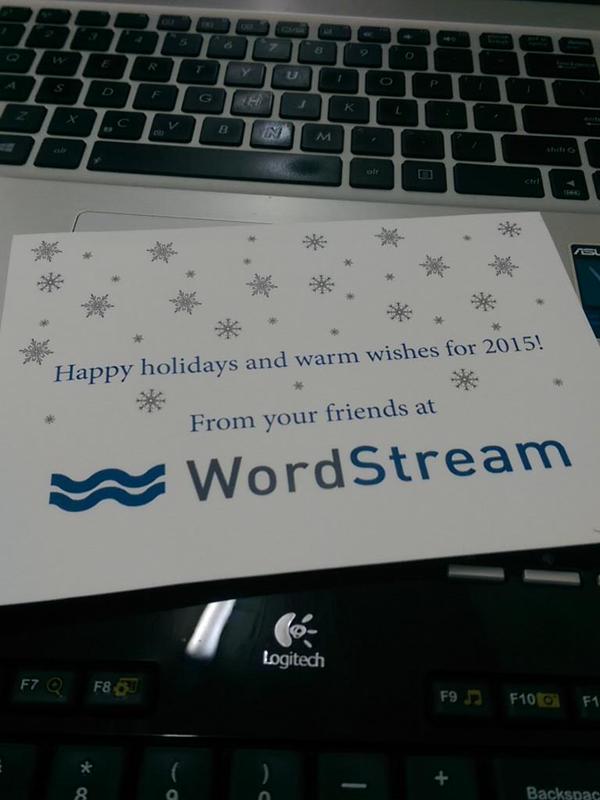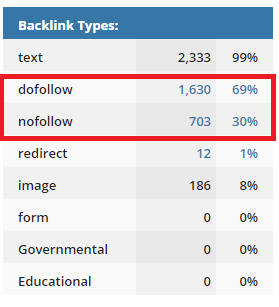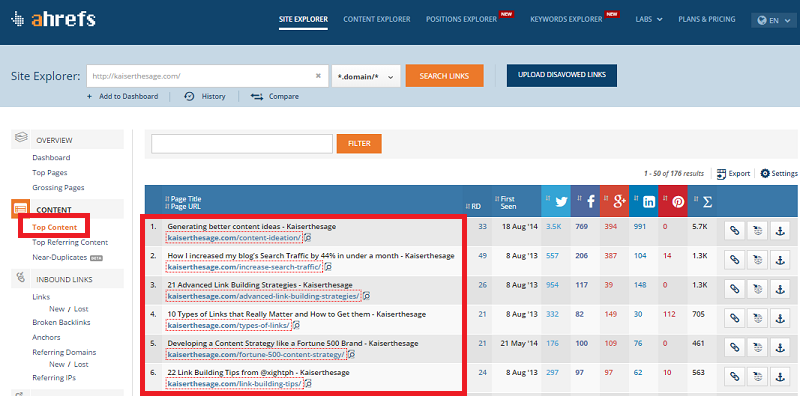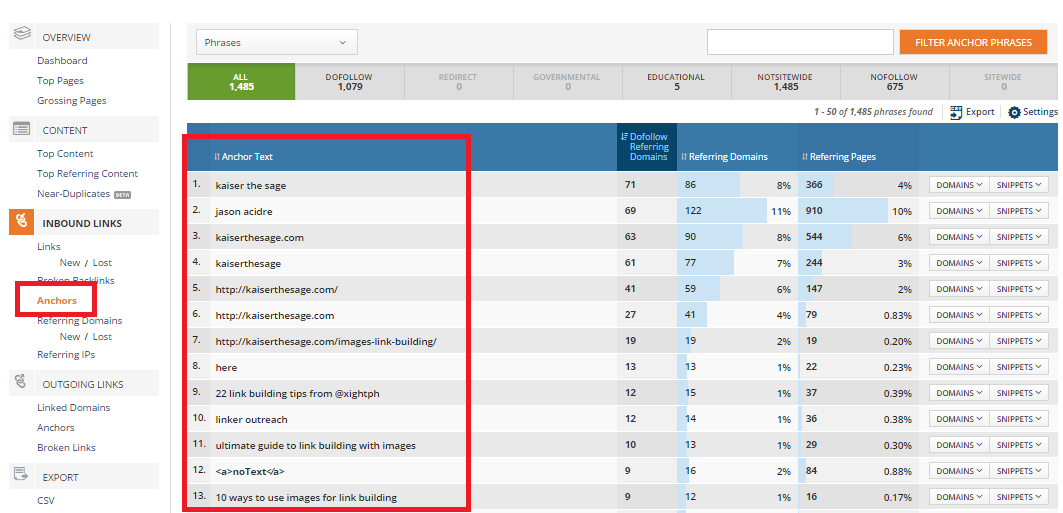How to Build Authority Links to Your Website
What are authority links?
Authority links are links found on a webpage with an established trust and authority to drive targeted traffic to a website that can help the brand achieve its business objectives.
Getting these authority links is tough. It requires hard work, creativity and persistence to find, pursue and connect to publishers and industry linkers who are interested in citing or referencing your content as a trusted resource to follow.
Link building is not for the faint-hearted marketers.
After all, if a link can be easily acquired by everyone else, it shouldn’t be called an “authority”.
However, despite its difficulty, online marketers still pursue this type of links as it can positively impact a website in many ways, such as:
- Sending targeted traffic to your page
- Generating leads and sales from referred traffic
- Improving search visibility of your page by making it rank for industry keywords
- Providing more link opportunities to your content (organically from researchers who can potentially cite you as a credible source of information)
- Creating brand awareness (as you’ll be linked alongside with influencers and big content creators).
“Authority” is pretty much subjective depending on what factors you consider.
But whether it is relevance or benchmark metrics such as Ahrefs DomainRank, it is important to understand what types of links are deemed to be authoritative. Given that this will be the roots of your link building approaches - your “how” in getting links.
Table of Contents
Types of Authority Links
Links from .edu and .gov sites
The legitimacy of an educational and governmental institution/organization being able to register a .edu/.gov domain is a way of the Internet preserving the authority and trust of this type of websites.
Although there remains a debate over the true value of .edu and .gov extensions, I strongly believe that what makes these sites authoritative is the information found on their pages. Incorrect, spammy or misleading details may lead to some drastic consequences on its end users (website visitors).
Authority .edu and .gov sites are hard-to-replicate links. Restrictions as to how relevant your page/site is to their own resource page make it more difficult for your competitors to get the same types of links - unless they’ve created a better version of your content or is associated in the same organization your brand belongs to (e.g. for local professional organizations).
Links from ranking pages for thematic keywords
The most powerful links on the web are the ones that can directly send relevant traffic to your site.
Ranking pages for targeted industry terms are great sources of new traffic from searchers looking for relevant information.
Acquiring links from them can drive consistent visitors to your site (not just one-time off - as what happens to a one-time guest post publishing).
Here are a few tips to getting links from rankings page:
Target relatively new resource pages. They are more receptive to outreach pitches than old links pages that haven’t been updated for year.
Given that they have just started curating topical resources/references, they are open for resource link requests.
Start your search with queries like, “inurl:resources “keyword” or “inurl:links.html “keyword”. Then set a time to past year/custom range (Tools - Time).
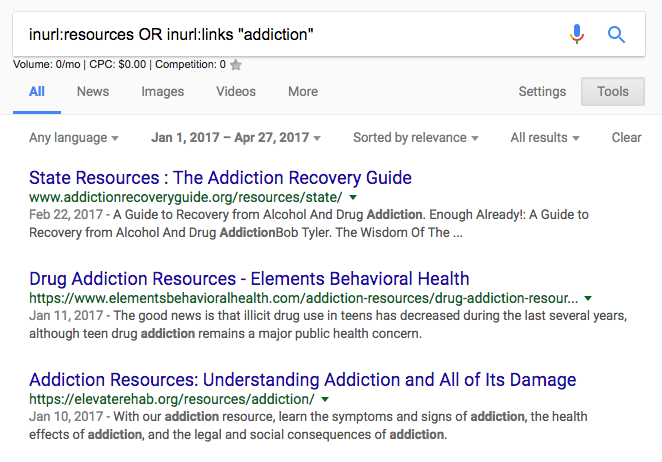
Contribute early to new industry publications. Investing early on topically relevant blogs (with high potentials for audience growth) by supplying them with regular content is a great technique to scale your link development efforts.
Because you’ll get higher approval rates as a columnist to contribute to low-authority (with high velocity for growth) publications compared to a high-tier news site in your industry.
Check the blog’s potential for growth using Ahrefs or SEMRush organic data.
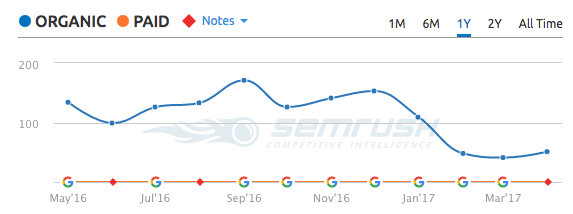
Begin this approach with your typical guest blogging queries. Then do the same process above (set a time to past year/custom range) to filter recently published “write for us” pages.
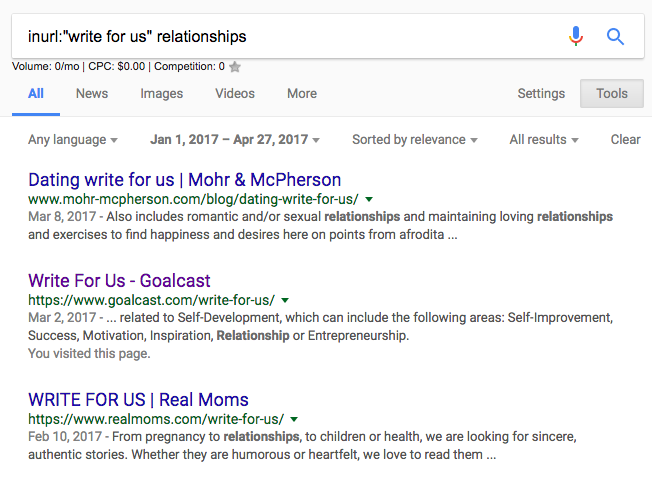 (hat tip to Jason Acidre for this technique)
(hat tip to Jason Acidre for this technique)
Further reading: Definitive Guide to Guest Blogging
Offer to update a static page. Informational content ranking for highly-searched terms should constantly be updated to satisfy its searchers’ intent, especially if the content requires the timeliness of the information (i.e. 2017 trends/updates).
This is where you can add value to the content creator by helping him update the page with new information and by adding other content formats (visuals, transcripts for video/audio, tables, etc..) - needed to make it 10x better than its competitors.
Links from top-tier news sites
Getting featured on A-spot blogs (media sites) can’t easily be replicated by your competitors because it requires relationships to make it happen.
If you have built connections with existing contributors from top-tier news sites, it’d open opportunities for your brand to be referenced as an authority expert in the industry.
Links coming from them (top-tier news sites) like Forbes is a great way to establish your brand’s authority.
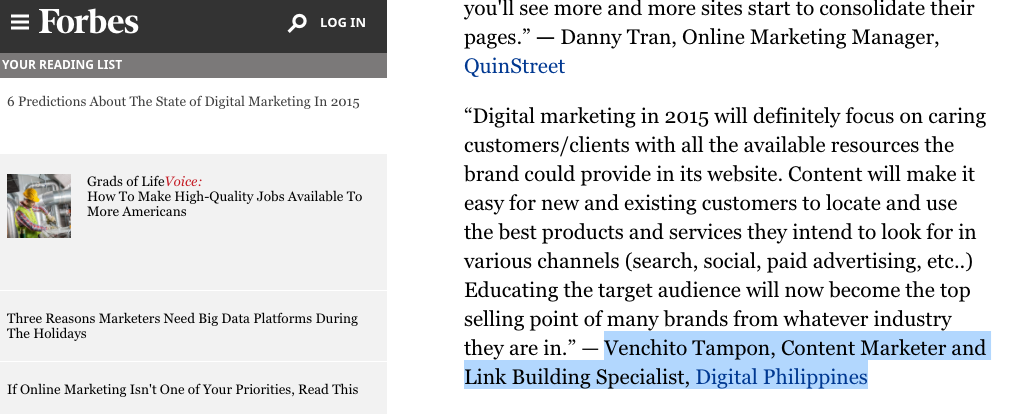
You can also add social proofs to your signature or email pitches when reaching to mid-level or high-tier blogs for content partnerships to build your site’s
Links from topically relevant websites
Consider a prospect page’s relevance to your site above everything else. You’ll find pages hosted on domains with low Moz DA but should be considered as highly valued link prospects since they can pass human’s eye tests - great user experience, satisfying content and with promising search traffic growth (which can be measured using SEMrush/Ahrefs).
See this DA11 finance blog as an example.
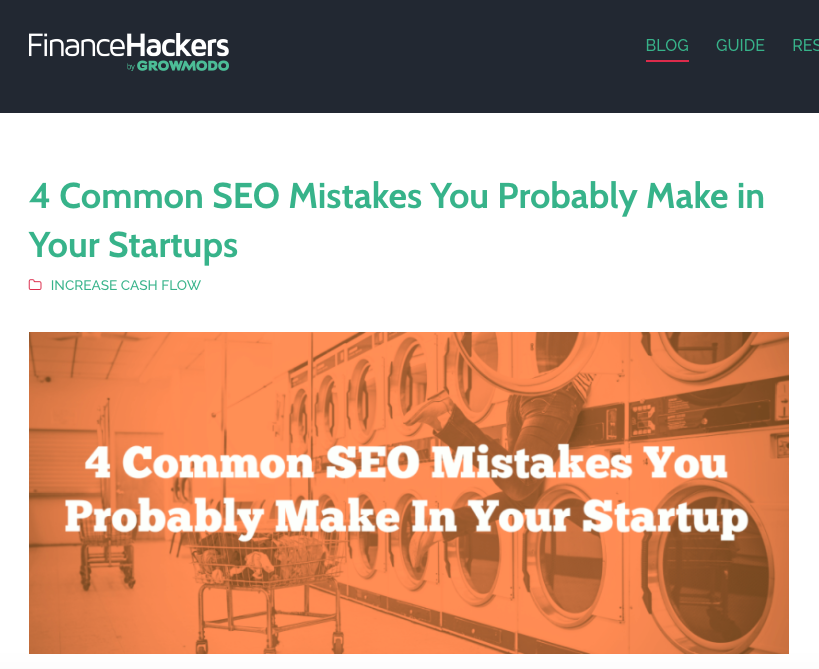 I liked the three primary reasons Jon Cooper listed why SEOs and link builders should consider prospecting for relevant blogs/sites:
I liked the three primary reasons Jon Cooper listed why SEOs and link builders should consider prospecting for relevant blogs/sites:
- Looking at relevance gives you more room for larger pools of link prospects.
- Relevant links have a bigger impact on the algorithm.
- Webmasters are more likely to award you with a relevant link since it makes sense for their audience.
You need to start prioritizing relevance today as your primary metric in link prospecting.
Links that generate business conversions
Links that are sending qualified conversions to your website are link types and sources you should replicate over time - as they directly affect your online business’ revenue growth.
Aim to get recurring links from these websites to increase more assisted conversions generated in your brand.
On Getting Authority Links
Authority links are hard to get. But if you’ll able to acquire them for your site, it would tremendously impact your site’s search rankings - helping you dominate the market you are competing in.
Authority link development requires either branding and/or content.
Summing them up is a powerful combination for link authority.
1. Perceived Branding
There are online businesses that don’t need 10x content to start getting brand awareness and establishing brand authority, as they have built it already using offline marketing platforms, such as advertising on billboards, television ads, and other offline marketing channels.
They have branded searches which enable them to generate leads and sales offline without having to depend purely on organic industry rankings.
If you are a consultant or an agency, getting clients who are widely known in a particular niche is a clear advantage on your end to develop authority links.
Because people are aware of the brand’s name, pitching publications and authority sites (.edu and .gov domains) for guest blogging, resource inclusion and broken link building are much easier to facilitate.
Ways to use perceived authority to get links:
A. Link reclamation
Find publishers who have mentioned your brand or product but haven’t linked to you. You can use BrandMentions to track them.
Then politely pitch them and ask for link attributions.
This technique has been covered many times, so here’s a guide you can check out that walks you through the entire process.
B. Interview opportunities
Use your branding to cover more interview opportunities wherein you can also obtain authority links to your site.
Make your existing press mentions and features of your brand as social proofs when pitching to industry publishers who’re looking for guests on their show (podcasts). The more credible you are as a brand, the higher the probability they’ll get you (or your client) as a guest for their show.
C. Incentivize social sharing in exchange of linking
If you’ve had a huge fan base in your social accounts, you can start using it as a value proposition when reaching out to bloggers in your space. Ask if they’d be willing to be featured on your social profiles (as long as their content feature provides useful information). In exchange, get an authority link from one of their pages.
D. Speaking gigs for natural linking opportunities
If your client is into public speaking, it’s best to check if you’re getting natural authority links from speaking pages/profiles of event organizers’ websites. There’ll be times where they’ll be linking to broken URLs/domains.
You can also monitor publishers who link to your client’s slide presentations and Slideshare profile and ask if they can cite your client’s website as a source.
 Chris Dyson wrote a guide on how to reclaim links from content creators that used your visual assets.
Chris Dyson wrote a guide on how to reclaim links from content creators that used your visual assets.
More reading: Using Brand Building Strategies to Improve Link Building
2. Content-based Link Acquisition
If perceived authority is missing in the formula, you can still get authority links by producing 10x content assets.
Smaller brands can win over big brands with an effective strategy to produce more content assets that can attract organic links.
As coined by Rand Fishkin, 10x content simply refers to content that is 10 times better than the best result that can currently be found in the search results for a given keyword phrase or topic.
Jason Acidre wrote a great piece on his own 10x content creation process (I advised you to check it out).
Here are a few effective techniques to acquire authority links using content:
A. Broken dead domain link building
Broken link building is a concept of pointing out broken links to webmasters, with the hopes that they’ll be open for requests to add your link, whether as a direct replacement for a previously broken link or as a new addition unrelated to the broken ones.
Here are some useful resources to get started with broken link building:
- All-in-one broken link building workflow
- The broken link building bible by Russ Jones
- Inverted broken link building strategy by Ahrefs
Maximize this link building approach further by observing what other similar resource pages have been getting organic links (quietly) in your space. They’ve gotten links you haven’t acquired yet that I’ve found, in most cases, can’t easily be found through Google search.
Track dead content (broken links) on resource pages using LinkMiner.
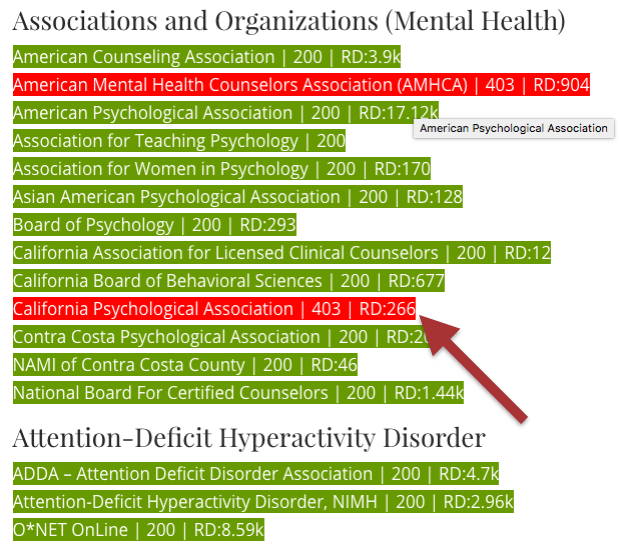 Set the options to display the number of referring domains for each external link.
Set the options to display the number of referring domains for each external link.
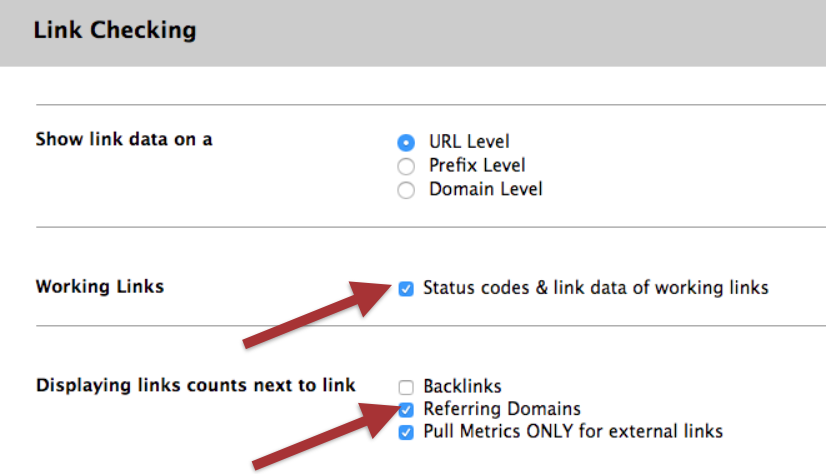 Check if the link is broken and if it does, do research further if it’s just a specific URL or prefix that isn’t working or the whole domain itself.
Check if the link is broken and if it does, do research further if it’s just a specific URL or prefix that isn’t working or the whole domain itself.
For instance, this video addiction content that I’ve found on a links page is part of the whole domain that isn’t working.
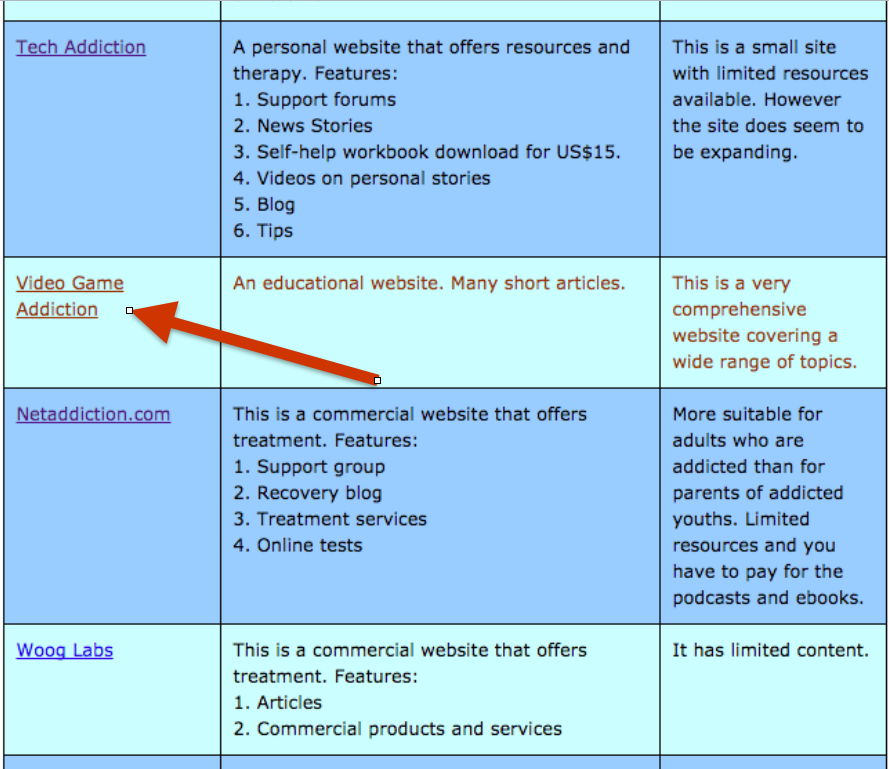
Gather resources/links pages pointing to the whole domain, not just to the specific broken content. Because there are other content in the site that gained high-authority links from other linkers as well - which provides you more link opportunities at one hand.
You can filter the results by link type (educational) to quickly extract .edu resource pages. Also, do quick searches for “link” or “resource” on Ahrefs referring domain search bar to easily get the same type of link opportunity (links pages).
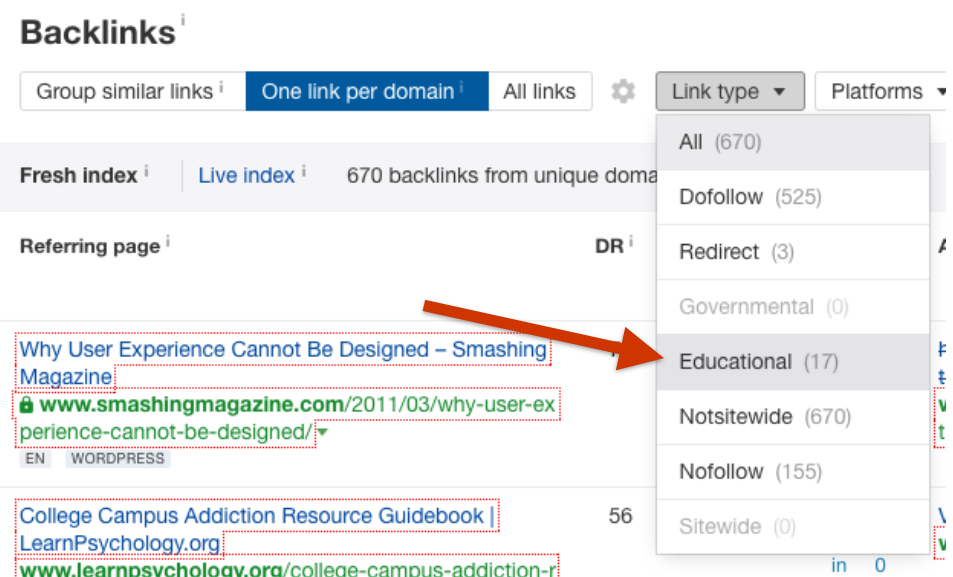
Reach out to webmasters letting them know of the broken content they’ve linked to from their pages. Then suggest your relevant content as a replacement to their defunct link.
To increase the efficiency of your outreach management work, it’s best to stalk your A-list sole operator webmaster and see if they have social accounts you can pitch to - straight to get their personal email addresses.
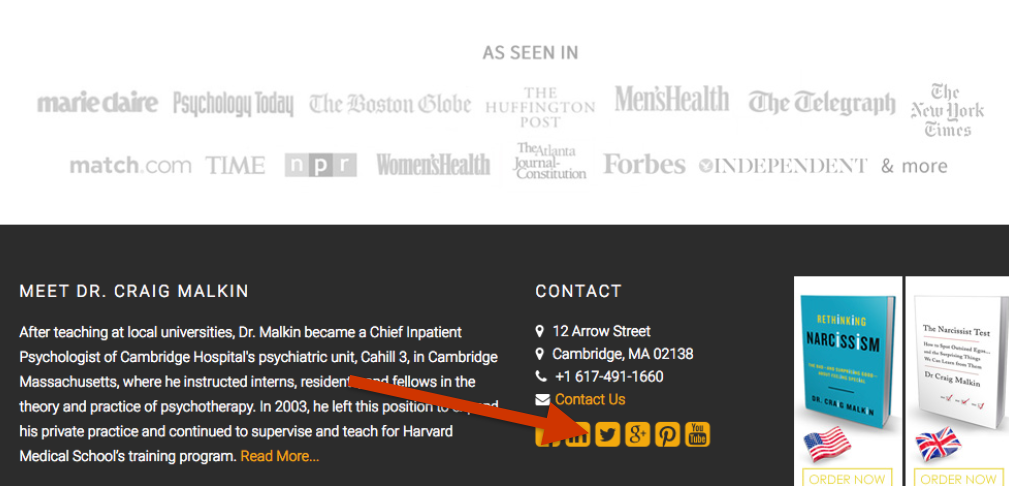
I’ve found this effective for personal blogs (with only one webmaster/operator) and for sites with no visible email addresses.
Instead of sending follow-ups to receive a response, you can directly ask them for a contact email they regularly use. Because other webmaster has more than one email address - you may be pitching to one that isn’t working anymore.
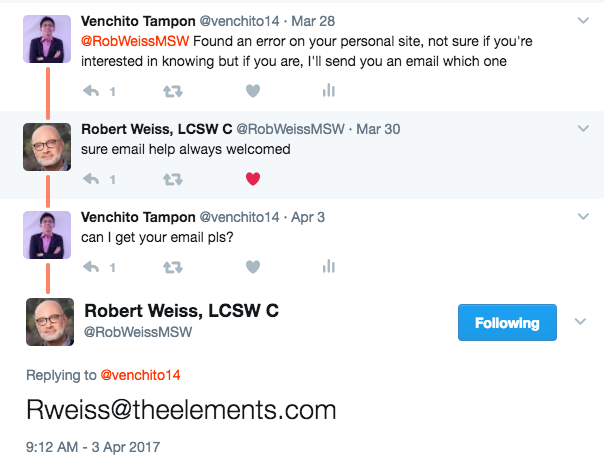
Plus, this allows you to see their interest to get help from you in providing errors found (broken links) found on their webpage.
Then acquire links:
 B. Reverse engineer new content assets with highest link growth
B. Reverse engineer new content assets with highest link growth
Reverse engineering other people’s content assets has been a standard practice in the link building space.
Since publishers/content creators have linked/shared a competitor’s content (or a website with a similar content of yours), you’ll have better chances of acquiring a link to your content - especially when your content is 10x better than what your competitors have.
Start by finding competitors’ content that are similar to the assets you already have.
But don’t stop from there. Find other non-competing but relevant websites with high-performing industry guides (those that received a substantial amount of high-quality backlinks).

Analyze their backlink growth further by checking the page’s link velocity. This approach allows you to get insights on how long have they’ve been building links or have been picking up links organically.
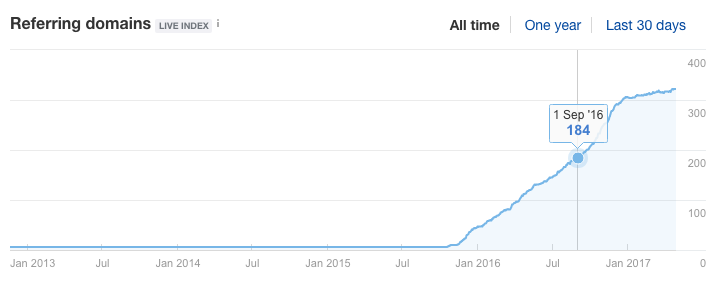
Because if they’ve acquired authority links just recently, their existing linkers are still at the stage of updating their pages/sites. When you reach out to them, you’ll have a higher probability of receiving positive responses.
You might also find other linkable audiences where they’ve been able to secure links that you might as well consider for link prospecting.
C. Linkable market analysis
Linkable audience is a group of resource curators who would benefit from specifically tailored information on a topic.
Starting a link development campaign by identifying linkable markets in the space can give you a better idea if a particular content topic is worthy to pursue for content creation. It is a guarantee on your end that there are audiences willing to link to your content asset, once it’s been created.
There are two ways to assess linkable markets in your industry:
Check the number of unique referring domains to ranking pages for industry terms
You can use Mozbar to see if there are pointing links to pages ranking in search results.
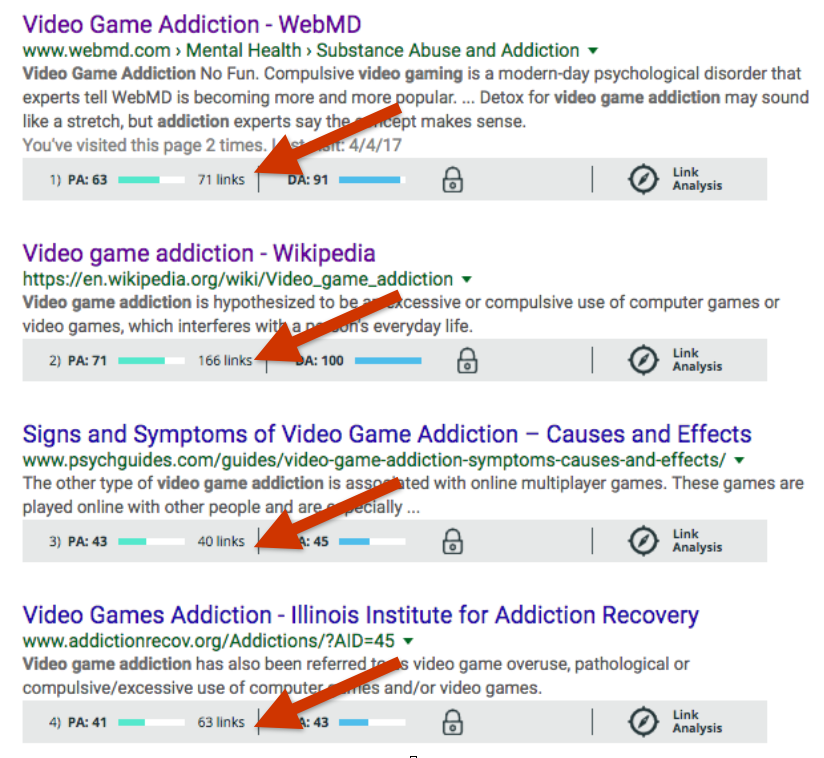
You may have to analyze further these links to see if they’re coming from legitimate websites/pages.
Intersect existing linkable audiences to your brand’s theme
Garett French created a list of 601+ linkable audiences whom you can serve with your content. If you can intersect your brand’s mission with different linkable markets, you’ll be able to generate more link opportunities for your website.
For example, this drugs rehab site published several pieces of content targeting different linkable audiences.
1. A Substance Guide for Parents
Linkable audience: Parents of teens who are struggling with substance/drugs.
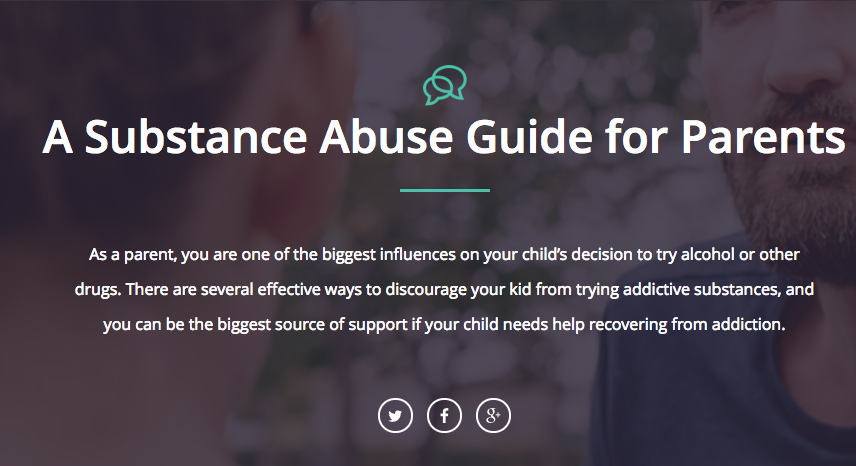
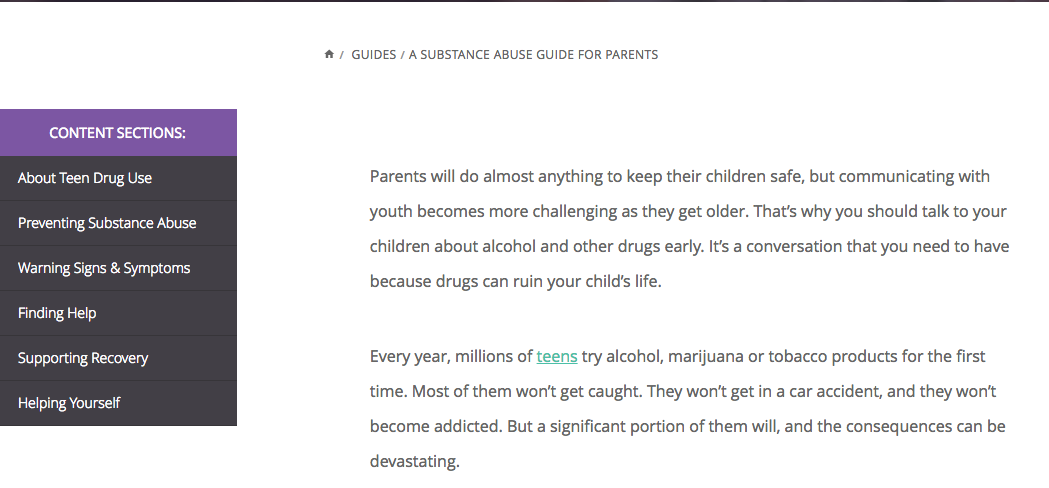
2. Bullying and Substance Abuse: Who It Affects and Why
Linkable audience: People concerned about bullying in schools.
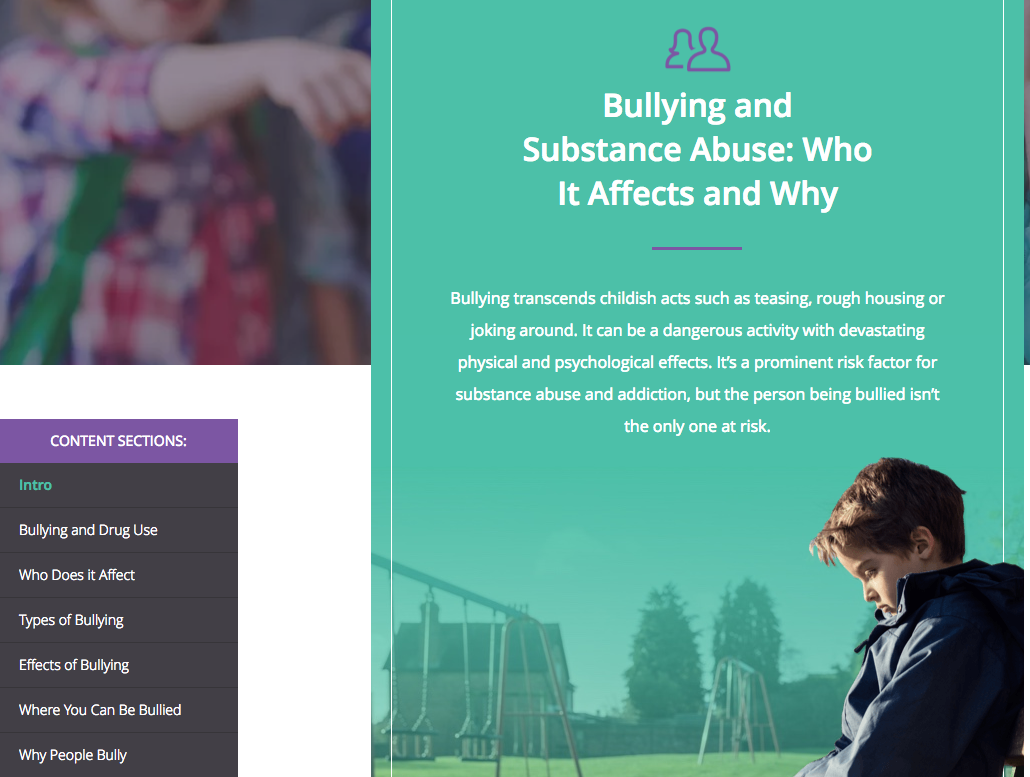
3. Degrees for Mental Health and Addiction Professionals
Linkable audience: Job seekers in the mental health and addiction niche

Linkable audiences:
- Parents of LGBT teens
- Parents of LGBT adults
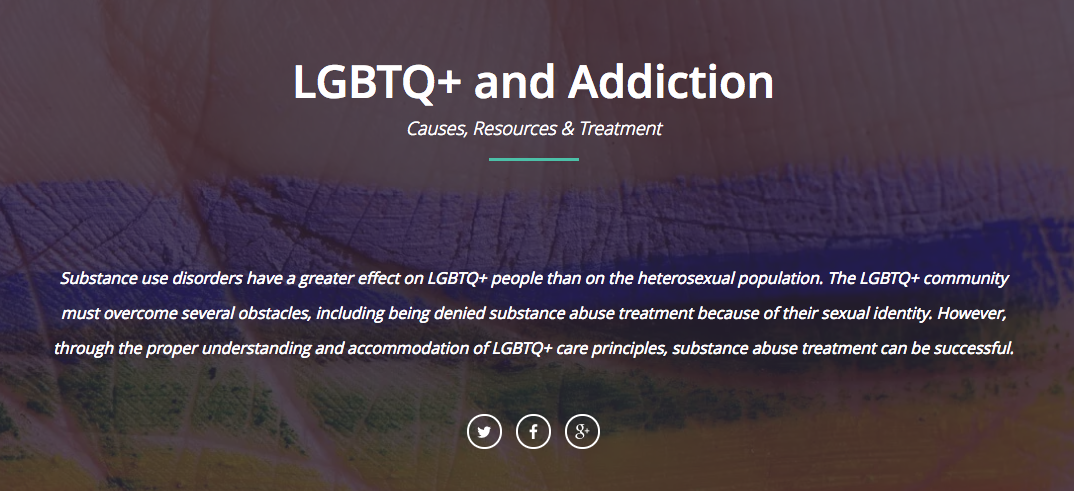
You may notice that these audiences served by resource curators (not necessarily bloggers/journalists, etc..) fall into one of these categories:
- a person in need, or a person who cares for a person in need
- a person seeking out information
If your clients have content pieces that are targeted to specific linkable audiences, you’ll have higher chances of acquiring consistent amount of authority links every month.
Further Reading:
- Link Magnetism - How to Create an Authority Site That Attracts Authority Links
- Earn 50+ Authority Links Per Month
Are Private Blog Networks (PBNs) Worth It In 2017?
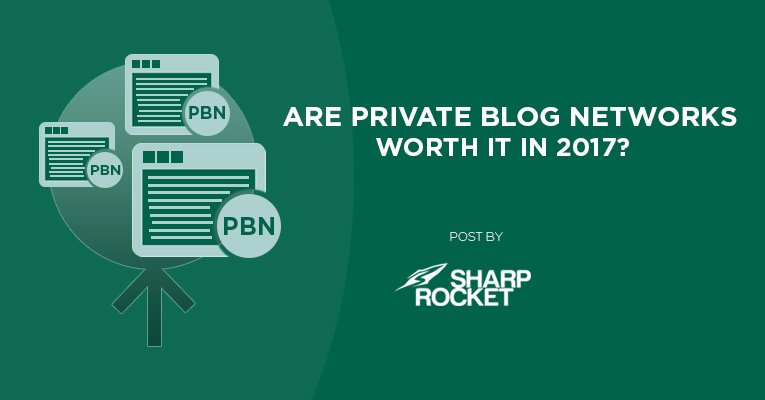

Table of Contents
I always get asked by SEOs, particularly those who have their own agencies why I’m not using PBN as my go-to-strategy in link building.
I’m not an anti nor pro private blog networks. If it works for you and you told your client the risks of doing it, that’s fine. Otherwise, you’re blindsiding your client.
This post reveals data of the return on investment of a private blog network.
I received 75 responses to the survey I did this month on everything about private blog network.
Let’s see what we’ve gathered here.
Note: This survey was done to gather simple data on the cost and time investment they take them to some immediate rankings for their websites. This is not the end all and be all of ROI on PBNs.
How many websites do you have in your PBN network?
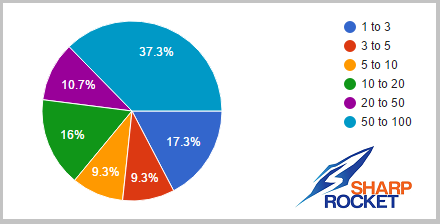

Respondents are heavily engaged in a Private Blog Network, with 37.3%, (28 of them) have 50 to 100 websites in their private blog network. A few reached out to me that admitted they even have a larger size, 100 or more websites in their database.
How much does it cost you to start each website? Including Domain, Private Whois and Hosting plus a few articles to start.
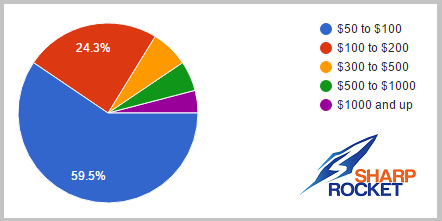

Similar to any website creation and development, private blog network owners take the time to setup a domain, Private Whois and hosting plus creating a few content pieces or pages to get started with it.
A whopping 59.5% of respondents invest $50 to $100 for each of their websites.
Among the 59.5% who invested $50 to $100, 15 of them have 50 to 100 websites, only 11 have 1 to 3 websites.
If you do the math, the highest prices might go between $2500 and $10,000 total setup cost! It’s a big amount for those who are just starting out and want to get immediate results.
How many hours every week do you spend for web development, content, plugins, etc.. for each website? – maintenance
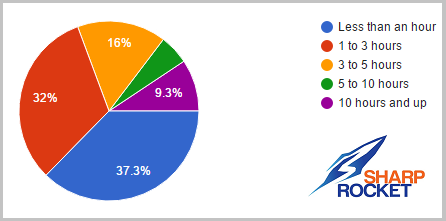

Let’s get to know the number of hours private blog networks owners spend for each of their PBN sites.
Over 37.3% of them spend less than an hour every week to maintain each of their websites. It may include adding SEO plugins, developing each webpage, publishing new content and other maintenance activities.
Out of 37.3 equivalent to 28 respondents, 10 of them have 50 to 100 websites while 6 only have 1 to 3 websites.
When you do the math, the longest time a PBN owner spends each week for all his websites ranges between 50 to 100 hours! It amounts to a full-time day job.
Do you outsource content for your PBN sites?
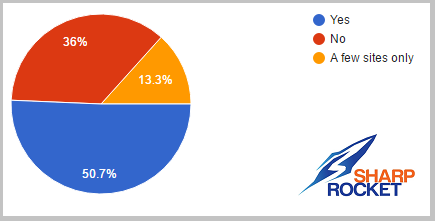

More than half of the respondents outsource their content creation tasks to freelance writers. If they have tons of websites (50 to 100 or even more), it’s wiser for them to outsource content as it is obviously time-consuming.
If yes, how much do you invest for outsourcing content for each site? (61 responses)
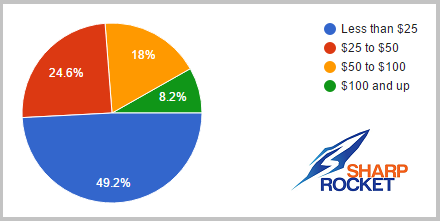

Among the sixty-one respondents, 49.2% or 30 of them invest $25 for the content of each of their sites, only 8.2% or 5 PBN owners spend $100 and up for outsourced content creation.
Out of 30 private blog networks who spend $25 content investment for each site, 9 of them have 50 to 100 PBN sites, only 3 have one to three websites.
If you do the math, the total cost for outsourcing content for PBN purposes is between $75 and $2500.
Do you use any SEO tools? How much do they cost?
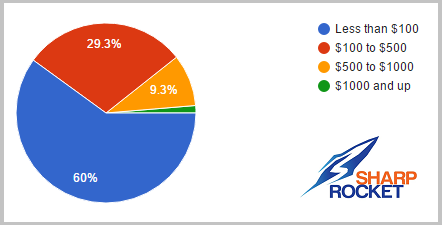

To scale some SEO processes like link audit, PBN owners definitely need SEO tools to help them with their work.
Sixty-percent (60%) of respondents invest less than $100 per month for SEO tool subscription. Others (twenty-nine percent) have $100 to $500 investment on search marketing products which will add to the total cost of their investment for private blog networks.
How many months do you see results in rankings to your money website(s) using PBN?
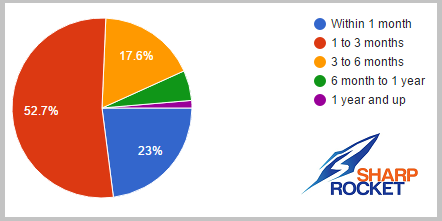

The real deal here is how many months they see search ranking results from their efforts. Fifty-two percent of respondents confidently say that they see immediate results within 1 to 3 months of doing SEO activities.
Let’s do the math both for those who own 3 websites and for those who have 50 websites.
Total cost of 3-site PBN network for three month period (though three sites alone couldn’t be considered as private blog network by some SEOs in grey/black-hat industry) is $525 (sum of $300 on website setup cost (3 month period) and $225 on outsourced content creation - 3 month period).
I doubt if they’re getting results from three websites alone.
The total cost of 50-site PBN network is $12,500, the sum of $5000 on website setup cost and $7500 on outsourced content creation (3 month period).
Do you monetize your PBN network? How much do you earn every month?
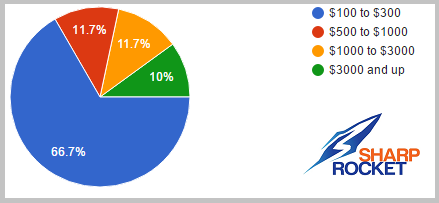

Aside from getting returns on investment from using private blog networks for their money websites, most, if not all, PBNs get returns from monetizing their own PBN networks. A large portion (66.7%) earns $100 to $300 per month. Others get $500 to $1000 and $1000 to $3000 every month from their PBN network monetization. I assume the latter two have more PBN sites than the former.
Different Ways to Invest $4000 a month ($12,500 for 3 months) Into SEO
1. Content creation
Content-based SEO strategies, especially if it is heavily invested in evergreen content can stand the test of time, and you’ll see initial and long-term results from this kind of work – increase in conversions, lead generation, so on and so forth. You can learn how to be more practical with content creation with this content writing post.
2. High quality backlinks
If you seriously want to focus on acquiring real backlinks that have growing traffic and can be placed editorially on highly relevant sites through guest blogging, targeted outreach and other link building strategies, you can invest that same amount $4000 a month on hiring one or two link building companies or hire a team of link prospects and outreach specialists to do the work for you ($4000 can hire 10 Filipino virtual assistants already). Automate it with proper link building sessions/trainings and management.
Further Reading:
Now it’s Your Turn…
If you are getting a return on investment using PBN network, then good for you. Take risk and let your clients know about it.
I know this is a controversial topic.
Do you have any questions about private blog networks? I’m not an expert on it (I don’t have one), but will ask other SEOs to come by and answer the questions for you.
Or maybe you have any insights or thoughts to add?
Either way, leave a quick comment below.
I'll be more than happy to reply to comments and answer questions.
How to Get Editorial Links to Your Website
Editorial links are the most powerful type of links given that it signals Google that the brand being linked to is a trusted resource/reference (either it is targeting the homepage of the site or its inner pages/contents).


There are three primary elements that can intensify your chances of getting in-content links for your website:
- Strong direct relationships with bloggers and content publishers in the industry.
- Content seen has a uniquely useful information and unexpected hook, which edges the content piece over pages hosted on competitors’ sites.
- The brand has a large influence over its community through its published high quality content and coverage/mentions from popular news/media outlets – which makes it easy for the brand to be remembered by top media/content publishers when writing posts for their blogs/sites.
Acquiring contextual links editorially from content creators requires extensive amount of effort and time especially for websites who’re still starting out to build their influence and authority from scratch.
Tactics that aim to consistently attract editorial links to your content/site would usually take 4 to 6 weeks or even months for brand new websites. Though they’re all time-consuming, these tactics that I’ll be sharing to you are not impossible to do.
Table of Contents
1. Trust marketing
Without trust, it is almost impossible to earn and editorial links, simply because content creators are keen to choosing credible sources/pages that they’d like to mention in their future works.
Trust marketing brings edges to new brands without enough to content to compete in the industry. With proper engagement and content development, new websites can now attract in-content backlinks from industry-related publishers with trust as its main component of link attraction.
Personalize your brand by choosing one team member (prefer it to be your site’s content creator) to spend most of his/her time producing high quality content pieces that’ll be published inside and outside of your company website.


Get him/her engage in niche-specific community platforms like forums and Q&A sites by providing direct and useful answers to topical questions in your industry. Spend at least hour every week for community engagement, because you’ll learn great insights from this activity – i.e. understanding the deepest needs of your target users, which you can use to create a user-generated content that targets a specific group of users (mostly potential linkers).
Wil Reynolds shared a very interesting presentation on conversion-oriented forum link building. He specifically discussed one ecommerce client who generated $11,000 revenue from a simple one-hour a week forum engagement.
Trust marketing can also yield contextual links from brands (with pre-existed relationships) through interviewing one of your brand publishers in their own blogs.

2. Invest in scholarships programs
For brands with big marketing budgets, setting up a scholarship program and publishing a page on it is one of the effective ways to earn reputable backlinks nowadays. Educational institution sites and government pages tend to link to scholarship programs that provides intrinsic value to their target visitors and users.
Though most of the time there’s only link that can be built from a single domain using this link acquisition technique (scholarship link building), still the relevant traffic and assisted conversion it can bring to the website are very much promising for the business.
This client of mine in the education niche acquired 62 .edu links through its scholarship program – which adds hundreds of referral traffic to his website and helps the site rank for relevant industry keywords.
You can request for a profile section from your target linker to explain more details about your program. This will entice users from other sites to visit your scholarship page and contact you for future partnership programs (this might get you additional editorial links from potential linkers).
3. Do secondary-competitor reverse engineering
Competitor backlink building is not just creating a huge list of backlinks earned/built by competitors but also understanding the relationships of linking pages and the page/site being linked to.
Reverse engineering (other term for competitor backlink building) can provide you an easy way to earn your first set of links (without need to prospect for targets from scratch).
The most common reverse engineering method is finding websites that currently rank in search results for your target keywords (either these keywords are commercial, transactional or blog-related).
Though this approach is pretty much powerful for local-based businesses, adding a few more ways to improve your reverse engineering process is definitely worth to try out in order to lessen footprints caused by building links also gained by your competitors.
Target links seen in resource pages as your secondary competitors when doing reverse engineering activity.
You can build a larger list of link prospects using this approach given that most of the time, links in those resource pages are not visible in search results.
Use Ahrefs, OSE or other third-party link analysis tools to track existing links of those secondary competitors. You can apply any of the following link tactics to acquire those editorial links:
- Pitch webmasters who have resource pages with broken links in them and ask if they’ll be interested to replace their defunct links with hyperlinks pointing to your website and to your other suggested resources (choose non-competitor links as your other suggested links, so as not to help your competitors gain the same amount of links your brand is getting).
- Contribute on industry blogs that have high search share and engagement level to build recurring links to your content(s) every week/month. Ask their content managers if you can apply to become their regular content contributors.
- Understand how your primary competitors (prospected from search results) and secondary competitors (other links in your target resource pages) acquired their current editorial links. They may have used any of these tactics: moving man method, press pitching or social link building.
Once you’ve created a giant list of link prospects through reverse engineering, you can now create a link strategy/plan to build those in-content links.
4. Profile editorial links from content contributor/speaking opportunities
A brand ambassador with a superb expertise in an industry often receives speaking and content contribution opportunities because he is recognized as one of the top influencers through his valuable contribution on top industry blogs and his non-profit social and community engagement.
Target corporate speaking and authority blogs for speaking and content contribution opportunities since most of the time, they allow individual profile pages for each of their contributors/speakers which’ll make it easy for target participants and readers to know more about their authors/speakers.
Other opportunities to earn editorial links from profile pages include:
- Sponsorship and exhibit programs for local and international events, which allows sponsors to expose their brand to a wide variety of potential customers/clients both offline and online.
- Local or international volunteerism on popular events with an opportunity to be mentioned in a volunteers’ list (specific brands) in a separate page of their website (there are cases that they also publish profile pages for brands who volunteered to the event).
Invest in networking with other brands in your industry (should be non-competitors) to earn unexpected in-content links from voluntary events in industry-related events and seminars.
5. Quoted insights
In today’s digital marketing, content creation is now a requirement for every brand who wants to build and earn non-manipulative links from reputable websites/blogs.
When producing high quality content, it is imperative to add unique insights/quotes coming from your brand ambassadors and content creators in order to make your content comprehensive to read or to consume.
This approach allows you to earn voluntary-given backlinks from bloggers and researchers who want to use your content creator’s quotes/insights contained in your content.
Make a consistent effort to produce high quality content on your website that have information that is found nowhere else (this element is commonly called unexpected hook).
6. Optimize your pages for natural language optimization type
Natural language patent was released last November as a method for Google to extract data from an authority page listed in search results in order to provide a direct answer to a specific search query.
This allows many authority pages to be seen by new search users as a recommended answer for a specific questions/query.
Add information to your page that is straightforward and that suits a specific search query or keyword phrase (e.g. symptoms of diabetes).
You can link to your page from other related internal pages in order for your new visitors to see your main target page. This will also help the page to increase its page authority and rank for that specific query.
This approach may help your page be seen by researchers or bloggers in that specific area, which will eventually help your content to earn editorial links from their blogs/sites.
Here are other resources that you can check out for more information on this topic:
- Direct Answers: Extracting Text From Pages Citations
- Direct Answers: How Answers Are Extracted From Web Pages
- Direct Answers – Using Query Intent Templates To Identify Answers
- Direct Answers – Taken From Authority Websites
- Direct Answers – Natural Language Search Results For Intent Queries
More Resource: How To Promote Your Latest Blog Post Like A Boss
8 eCommerce Link Building Strategies That Really Work
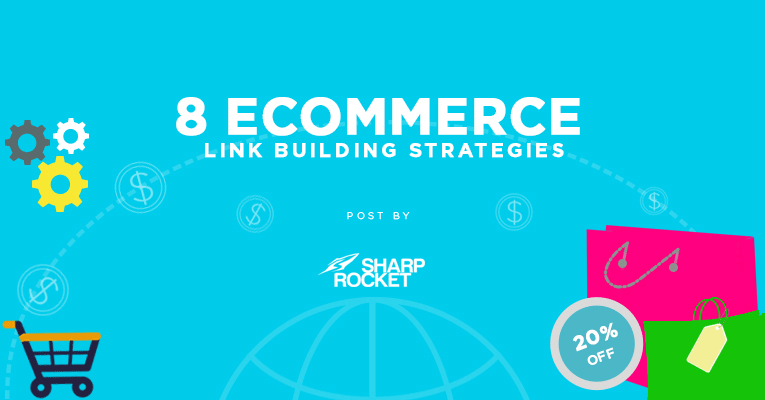

The promising ecommerce sites are emerging in various industries today, which gives tight to the competition as years are passing by. Marketers from these online shopping sites are finding ways to be better at servicing their target audiences, building strongly their own brands and ensuring they’re getting ahead of others in online search.
What strategies ecommerce sites require from marketers to make these properties optimized for search are as difficult as tactics required to generate links for these sites’ important pages - considering the low linkability nature of product and category pages.
In this post, I’ll be sharing to you 8 link building strategies for ecommerce sites – some are common to you but I guarantee you’ll still get some new tactics here.
Let’s get started.
Table of Contents
1. NETWORK-FOCUSED LINK BUIDING
The low-hanging fruits of links will come from those people you are connected with. They can either be your manufacturers, dealers, retailers, suppliers, service providers, sponsorship partners, event organizers and other networks you engaged with up until today for any kind of business reasons.
To get started, if you are a reseller or retailer of products:
STEP 1: Grab a list of all goods you are licensed to sell and from there, you start looking for available “where to buy” / retailers / dealers on their sites. You can use Ahrefs to export an inventory of products you are selling online, then create a list of websites where these products came from.
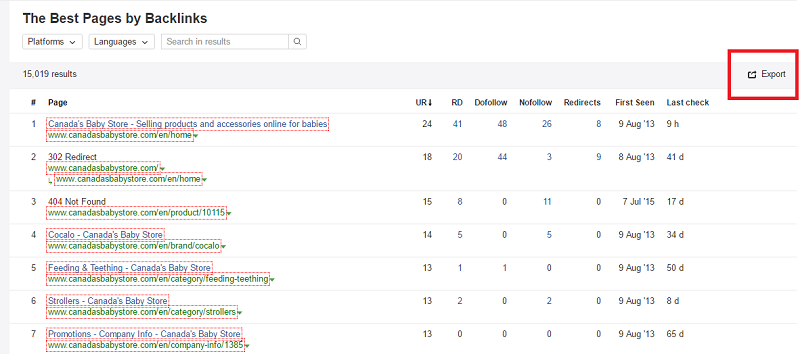

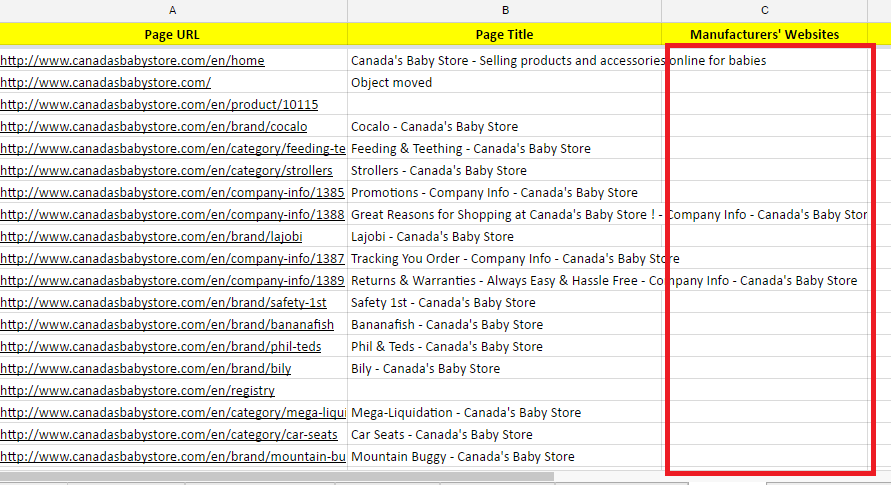

STEP 2: Once done with the list, search individually in each site for any available partner list pages. You can use the search operator, “site:domain.com” plus any of the following keywords:
- Preferred retailers
- Related Links
- Partners
- Authorized Dealers
- Where to buy
- Online retailers
- Online dealers
- Find our products
- Additional retailers
- Internet resellers
For example, if you are reseller of Cocalo, then you can do a simple search on the site and grab their where to buy page.
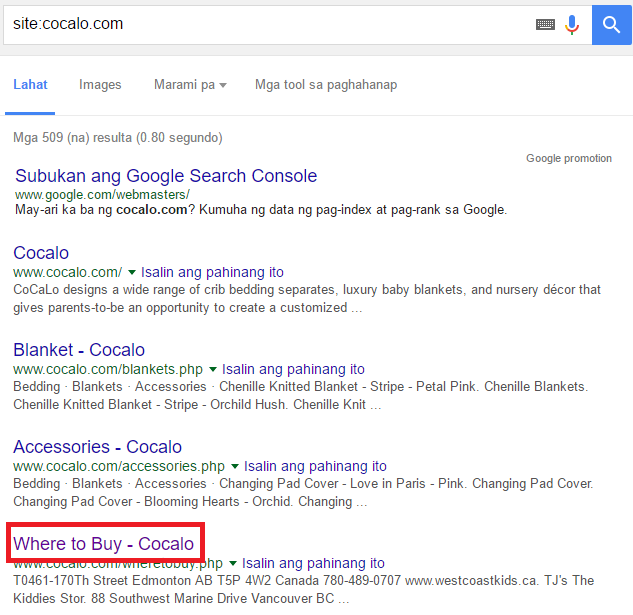

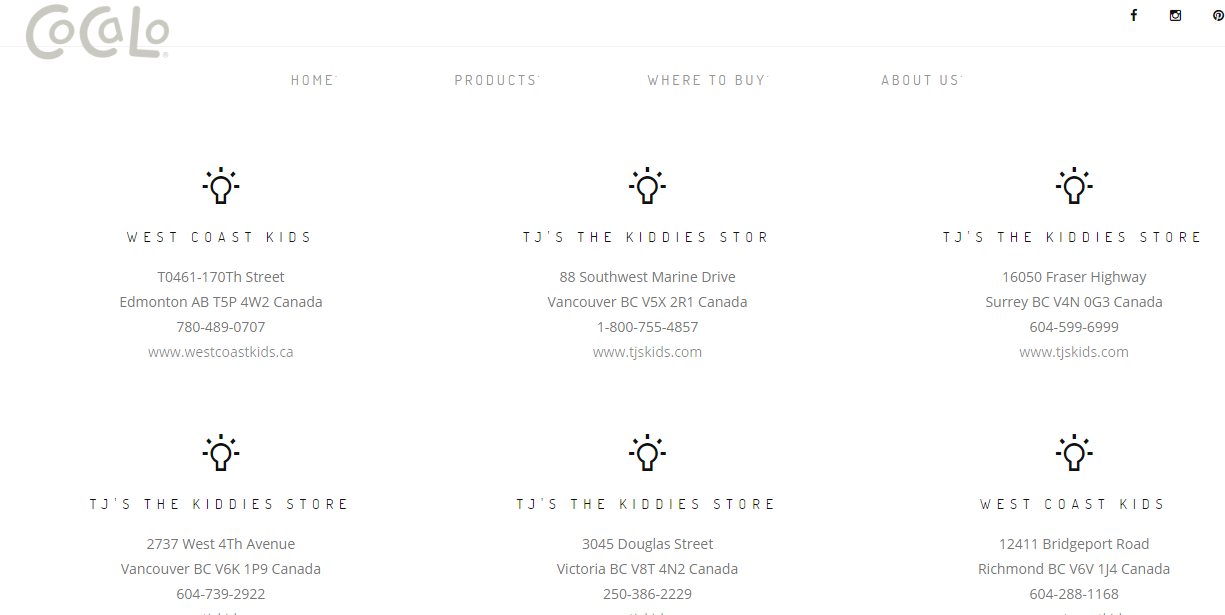

STEP 3: Collect contact information from target link opportunities and reach out to them. You can use this email template below:
Hi [Name],
I’m Venchito from [eCommerce brand], an online shopping site on [niche]. We started selling [BRANDX] on our website since [date].
I saw your “where to buy page” [LINK1] and wondering if we can also be listed as one of the resellers.
Looking forward to hearing from you.
Thanks!
MORE ECOMMERCE RESOURCES:
2. IMAGE-BASED LINK ACQUISITION
Images have formed a huge part of the web for the past decade, seeing its very importance in visual experience and in defining basic information or data online.
True enough, if you started maximizing your visual assets on the web, it couldn’t just help your site build a better site user experience, but also in assisting your site’s link acquisition process.
If you’ve been working on image-heavy industries, it’ll be advantageous for you to explore link opportunities from blogs that need help in curating high-quality images. After all, who doesn’t want original high-resolution images for their content assets – i.e. blog posts?
How to maximize your site’s images?
Step 1: Go to your image database and look for visual assets that can be distributed to bloggers. You can use the image Google search, type in site:domain.com and click on the Images tab.
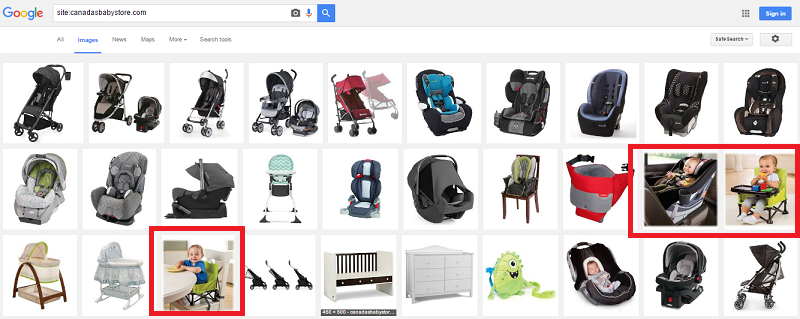

Step 2: Curate a list of bloggers that you think will highly benefit from your images – use your preferred metrics to gauge blogs’ authority (Ahrefs Rank, Domain Authority), but I much prefer SEMRush traffic as a valuable metric for this link building strategy, since you also want to look for valuable estimated organic traffic that you can drive referral visits to your website.
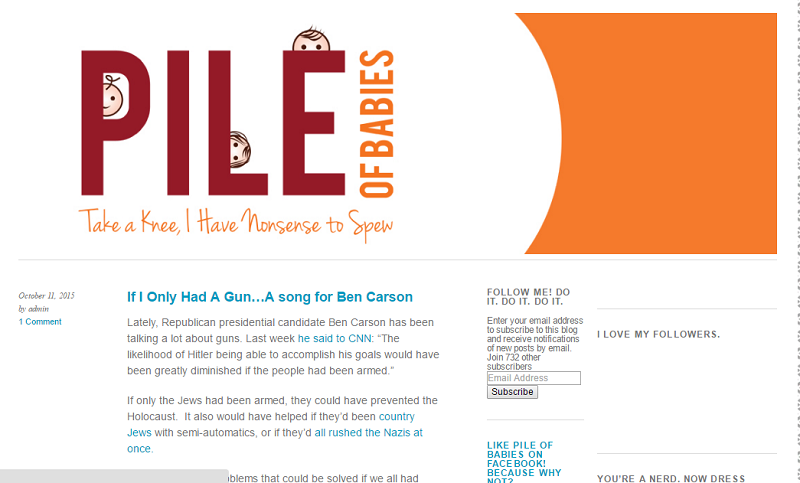

Step 3: Reach out to your listed blogs and offer your high-quality images. Pro tip: use exclusivity as part of your initial pitch (we exclusively offer these images to you..)
Hi [Name],
I was looking through your website and noticed that you have a lot of great content about caring for babies, parenting and maternity. Just wanted to let you know that I can offer you high-quality images that you can use for your existing and new blog posts. These are all FREE and EXCLUSIVE for your blog.
Let me know if you’re interested and I’ll send the images right away.
Thank you,
Venchito
Step 4 (optional): Track blogs that acquired your images but haven’t credited you as their sources. Given that your visuals will be featured on other blogs, there are high chances that their readers can also get your images.
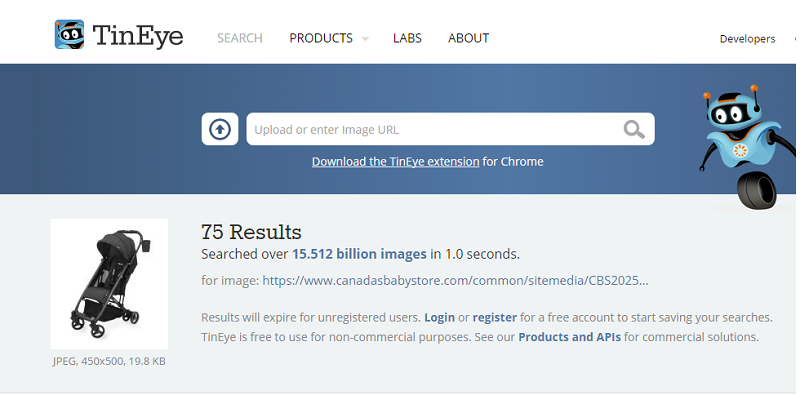

3. HORIZONTAL/VERTICAL COMPETITOR LINK ANALYSIS
One basic yet undervalued skill in link building is the ability to identify the right competitors. You may be thinking of all pages/sites that are ranking on the first page of search results for your target keyword as your direct competitors – but this is just beneath the surface.
If you see Amazon is on the top spot, it isn’t smart to go find all pages linking to this big website.
How you can identify your direct competitors and build links from pages they recently acquired from?
Step 1: Go to DMOZ and use it to find competitors based on horizontal and vertical niche levels. Let’s say you are selling handcrafted furnitures, your horizontal-based competitors are sites in this list. Make a list of these direct competitors.
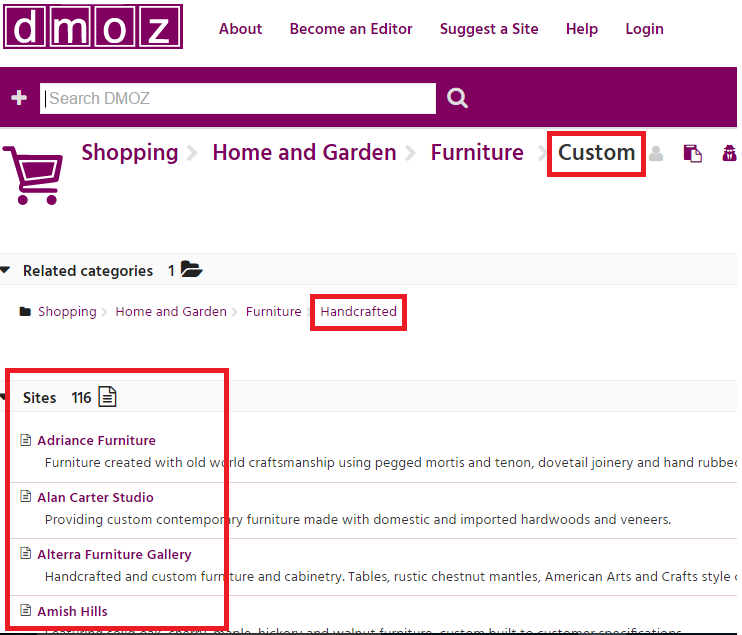

Step 2: Add to your list vertically-related sites by going a higher level in the Breadcrumb and finding sub-niches aside from Handcrafted. You’ll then see sites that sell different types of furniture – home furnishing, traditional, modern, so and so forth. These sites may offer products to similar target audience and you can guarantee that they acquire links from same types of websites.
Note: You still have to qualify them, but overall, you’ll get some big opportunities you haven’t found yet.
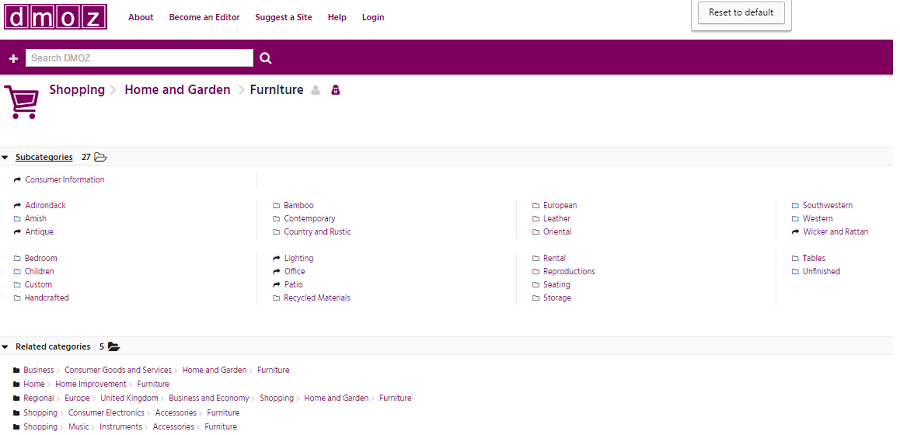

Step 3: Once you’re done list, plug in each of your direct competitor site (horizontal and vertical levels) and see their newest (recently acquired links) – see New Backlinks section.
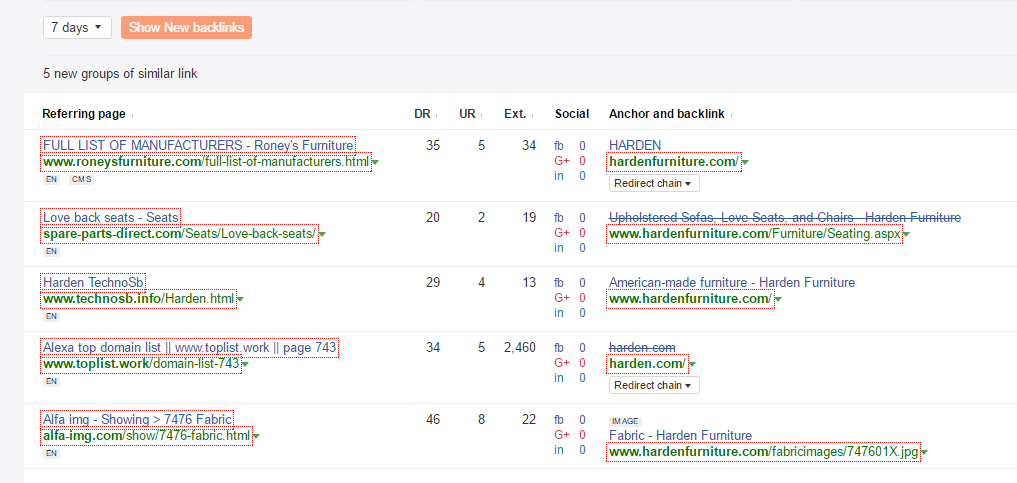

Step 4 (optional): You can look for more new backlinks by showing 30 or 60 days view of recently added links.


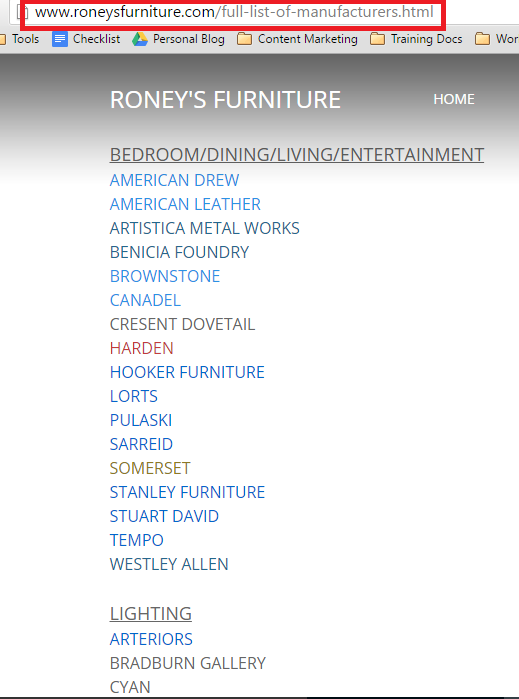

Step 5: Once you've gathered and qualified potential link targets, you may now reach out to them and ask if you can be added to their links/resource page. There is a higher link acquisition rate using this link building tactic since bloggers and webmasters are still in the process of updating their pages/sites.
Hi [Name].
I came across your [“list of manufacturers”] page and I noticed that you recently included [COMPETITOR BRAND] in your list.
We are also a manufacturer of [niche] products for local audiences in the US. I wanted to reach out to you directly to see if this would be a good fit for your [resource page]. You can see our recent products here:
Thanks,
Venchito
4. GENERAL ECOMMERCE LINK OPPORTUNITIES
There are a few gold mines that most eCommerce link builders aren’t capitalizing on, but can actually provide real link value to their websites. That is pursuing links in eCommerce and retail industries (general).
If your site or your client is open for publicity, then this link building strategy best fits for them. How to do it?
Step 1: Do a Google search for any of the following search phrases:
- eCommerce events OR seminars [city] OR [national]
- eCommerce “guest post” (example)
- eCommerce “gift guide” (example)
- eCommerce holiday guide
Step 2: Make a list of all possible link opportunities from sites/pages you prospected on.
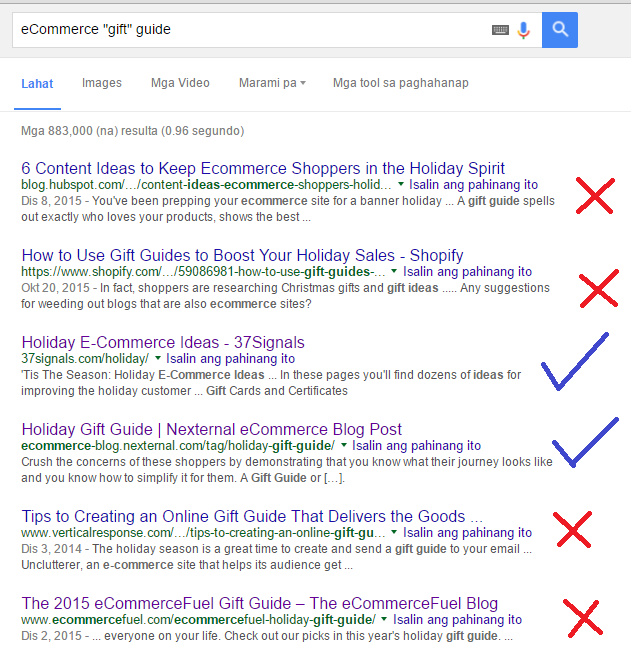

Step 3: Strategize how you can acquire links from those eCommerce-specific sites. You can either do a guest post on their blogs, attend to their local or national events where you can build relationships with the organizers, or simply asking them if they conduct interviews with eCommerce site owners or marketers.
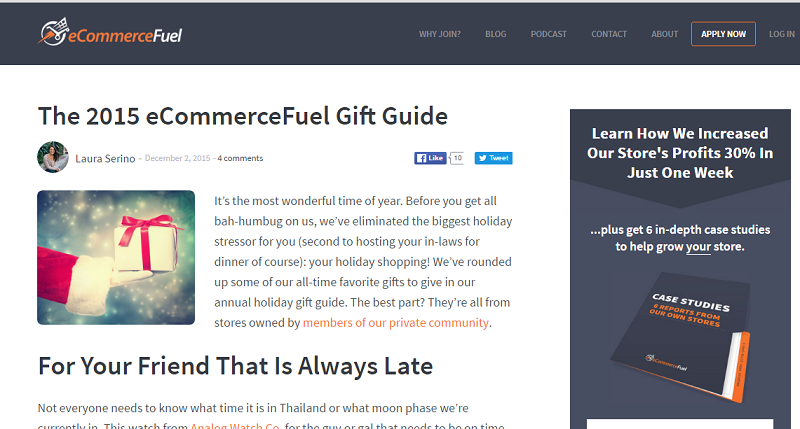

5. GET LINKS FROM CATEGORY-SPECIFIC COMPETITORS
Resource page link building is one of the classic link building strategies that you can maximize for eCommerce websites. There are, in fact, hundreds of links or lists pages intended for updates – corrections and additions on a regular basis.
If you always take time to find broken links and suggest webmasters with relevant resources (including your content), then it’s a value added proposition you can offer in manual outreach. However, this is not a necessity in eCommerce resource page link building. If you follow the next steps, you can certainly acquire links to your eCommerce target page(s) from relevant resource pages, even without the broken link UVP.
Step 1: Identify what page(s) you’d like to target to funnel your link equity through. I always recommend targeting some highly converting category pages to pass its link authority down to its products pages – they are also more linkable than individual product pages (assuming these category pages have clean layout and design).
![]()
![]()
Step 2: Look for sites that solely sell a product in your category. Let’s say, for orthodontic supplies, find sites that sell retractors and disposables. A simple Google search for where to buy” [ product ] will provide you these product-specific competitors.
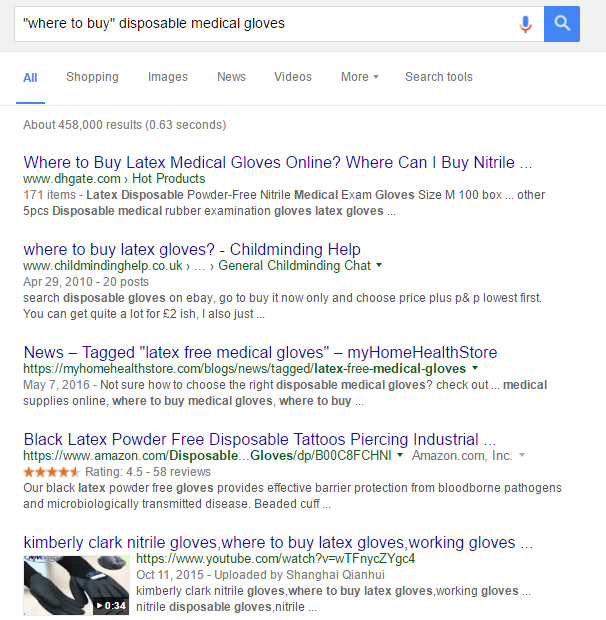

Step 3 (optional): If you can’t find any sites that just sell very specific products, you can find category-specific competitors. In our example, you may look for websites that sell orthodontic instruments or dental websites that have orthodontics category page.
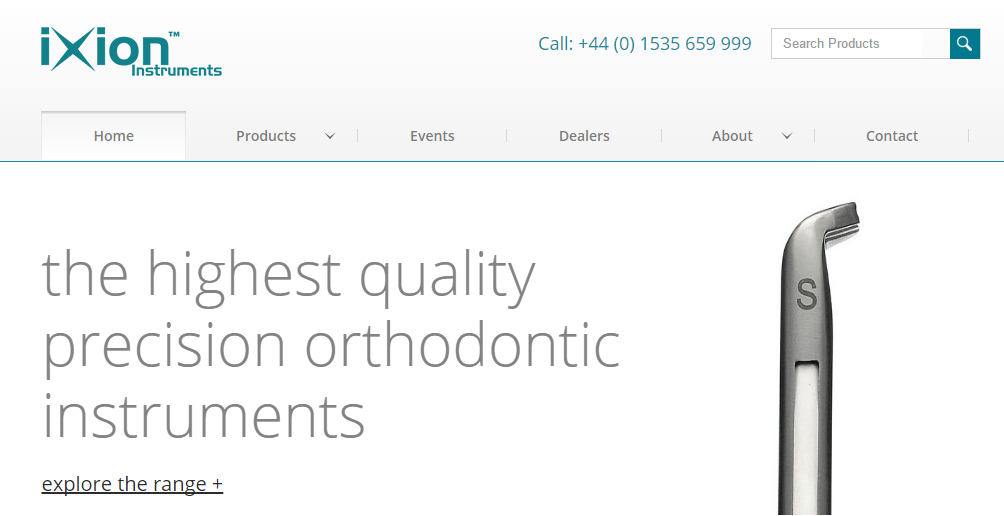

Step 4: Once you have a list of product and category specific competitors, you can plug them into Ahrefs to find resource pages they’ve been linked to. For category pages, make sure to use the Exact URL option for search link bar.
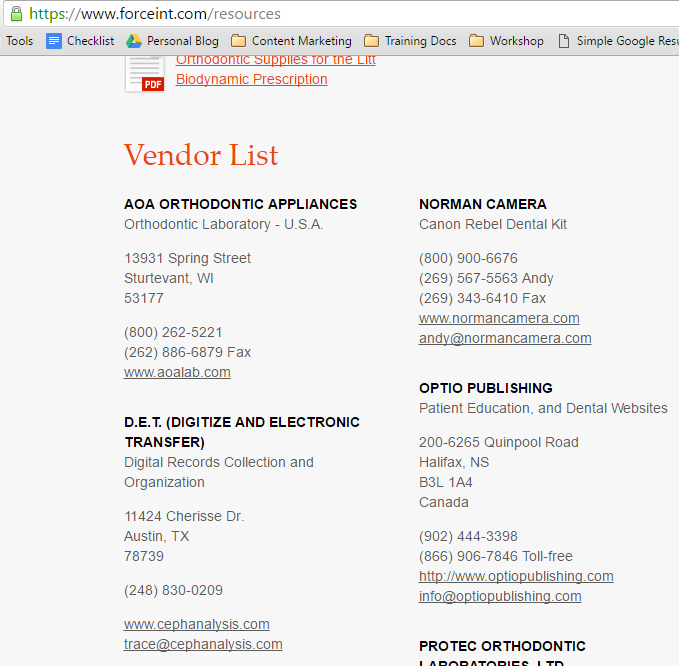

https://www.forceint.com/resources
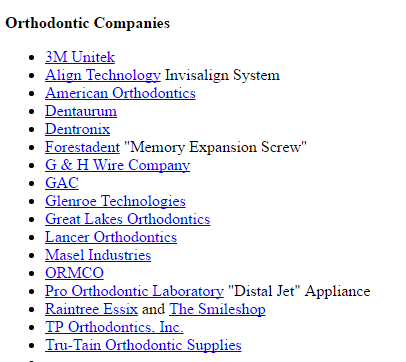

http://www.orthonj.com/links.html
Step 5: Make a list of possible resource page link opportunities in Google Spreadsheet. You’ll most likely get two types of resource pages: one that linked out to just one/two products (e.g. retractors) and another page with all external links related to orthodontic supplies.


Step 6: Hunt for the email addresses of your link prospects and send them emails. If you see a page that has an instruction as to what email address you should be directing your email to or that tells you what kind of resources they’ll only consider for resource inclusion – it would be wise to make use of it as your introductory sentence in your initial pitch. This will dramatically increase your response and link acquisition rates from pages with direct instructions about corrections and additions of resources.
i.e. “I noticed your note at the top of your exhibit resource page about corrections & additions, so…
6. TARGET MONEY-SAVING AUDIENCES
Coupons and discount pages are enticing offers online customers will certainly avail – taking advantage of people who are trying to save a buck is a link building opportunity for those in the eCommerce space.
Having said that, here’s how you can benefit from coupon-based link acquisition campaign:
Step 1: Create a dedicated landing page for deals or coupons. Well-designed page targeted to specific audiences will perform better in acquiring niche relevant links than plainly having a general deals page. Here is one example of a website that regularly publishes deals pages mainly targeting gadgets and technology equipments.
Pro tip: Use this as your angle when pitching bloggers (I’ve created a dedicated deals page for your readers…)
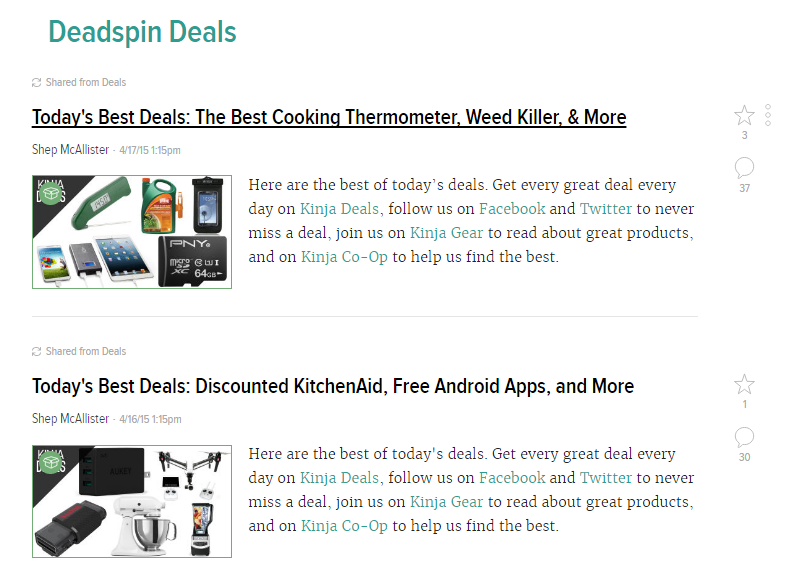

Step 2: Find both niche-specific and general coupon blogs by doing a Google search for intitle:coupon “blog”. You will then see a list of coupon sites who are targeting the same audience: people trying to save money. Here are a few general coupon blogs you can initially pitch:
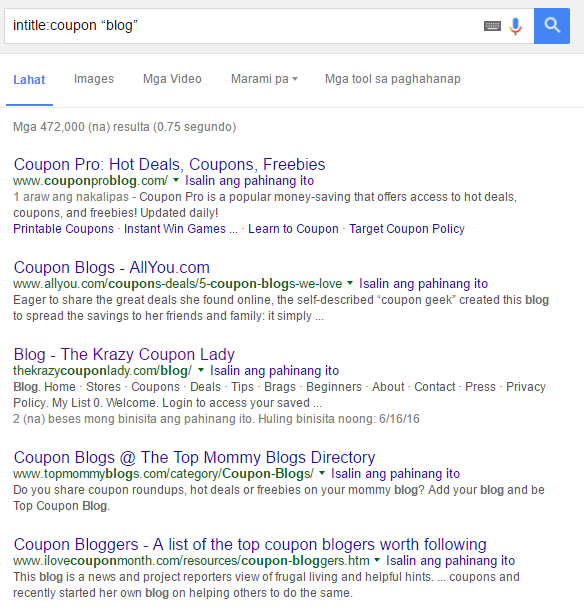

Step 3: Invest in building relationship with these coupon bloggers by giving them offers they can’t resist. One way is to use the dedicated page as your unique proposition, another is to get them as partners, so when you release a new deals page (only applicable if you sell different types/brands of products), you can make initial exposures from your offers.
7. IMPROVED GUEST BLOGGING TECHNIQUE
Guest posts are external web properties considered to be valuable assets for a company or website – given that it has so many benefits anyone can took advantage of, such as:
- It helps attract new social followers to your brand’s social profile accounts (these people may have read your guest articles on other blogs), which can semi-automate the distribution process of your existing and/or future content assets hosted on your site.
- It helps bring new converting visitors to your page/site – who can become potential email subscribers and customers of your brand.
- It helps build brand awareness and authority in your niche, especially if hosted sites are top-notch blogs in the industry since you are tapping into new groups of target audiences.
If you are still not convinced how powerful guest blogging is, you can check out more of these resources.
For eCommerce brands, guest blogging still works but not to the extent of using it solely for link acquisition – a balance between guest blogging and broken link building is a good example.
I had a client in the coupon ecommerce space that targets audiences in the parenting, relationship and mommy verticals. By using guest blogging strategy plus other link building tactics, we’ve helped the site gain organic increase on a month to month basis.
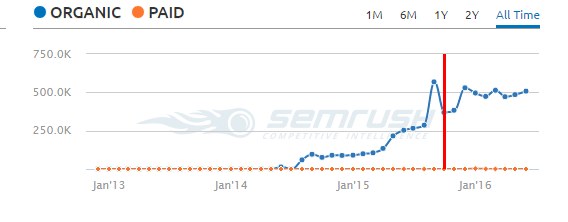

A few examples of contributed content articles are here, here and here.
Let’s learn how to use guest blogging campaign for eCommerce sites.
Step 1: List down category pages of your site that you are trying to rank for in search and have history of high conversion gains – it’s much easier to see monthly improvements from converting categories than random allotment of category pages.


For starters, use inurl:blog “niche” OR inurl:write-for-us “keyword” to make an initial list of guest blogs.
Step 3: Pitch with content ideas not being covered in their blogs (you are likely to get more responses using this approach since you are giving more value than other publishers just trying to land a coverage with general content topics).
You can find existing posts from industry-related news sites for rewrite or recreation and use them as an angle for guest blogging pitch.
You can also contact book authors, experts and influencers in your niche and ask if you can do an interview with them – use the output interview as the finalized guest content.
Pro tip: Make sure to add internal links to guest blog’s other content in your guest posts – it will help increase the chances of getting your posts approved by publishers.
8. TRIPLE-FOLD LINKBAIT PROCESS
Linkbaiting is a form of viral content marketing aims to attract links from linkeratis – coined term for people who might give links to a content.
It is a combination of efforts focusing on three main elements: usability, evergreen and unexpected hook (source).
Knowing which type of content are useful for a specific type of audience, identifying how long a particular content can benefit its target audience and adding information and data to the web asset not yet discovered on other external sources are main ingredients towards a successful linkbait strategy.
There are various forms of linkbait content now being used by marketers, business owners and agencies including extensive/comprehensive tutorials/guides/resources, visual data/information (data sources both internal and external) and expert advices/tips on a subject matter.
Each of these types can consistently provide results to your brand – i.e. bringing more specifically targeted leads and driving more traffic (organic/direct/referral) to your website and upgrading your blog/content readership.
One example of a linkbait content that is often used in different industries is round-up post. You can see this type of content even in the most specific niche and common vertical.
Unfortunately though, most link builders don’t have a concrete plan of using round-up posts – obtaining low number of shares and links on a content with 100+ contributors.
A few reasons why it isn’t effective for some marketers:
- There is an initial intent of just building links and the primary reason why it was built – leaving no doubt that it got only a few shares from contributors.
- Not all tips are valuable – asking questions to general practitioners, not actually an expert on a subject matter would result to low-par information.
- Setting minimum number of works in answers when pitching potential contributors results to sub-par content output.
Here is how to leverage linkbait content like round-up post to acquire high-quality links to your website:
STEP 1: Create a top niche experts to follow content to initiate conversations with industry influencers. The pure intent of publishing the content is to build relationships with possible contributors.
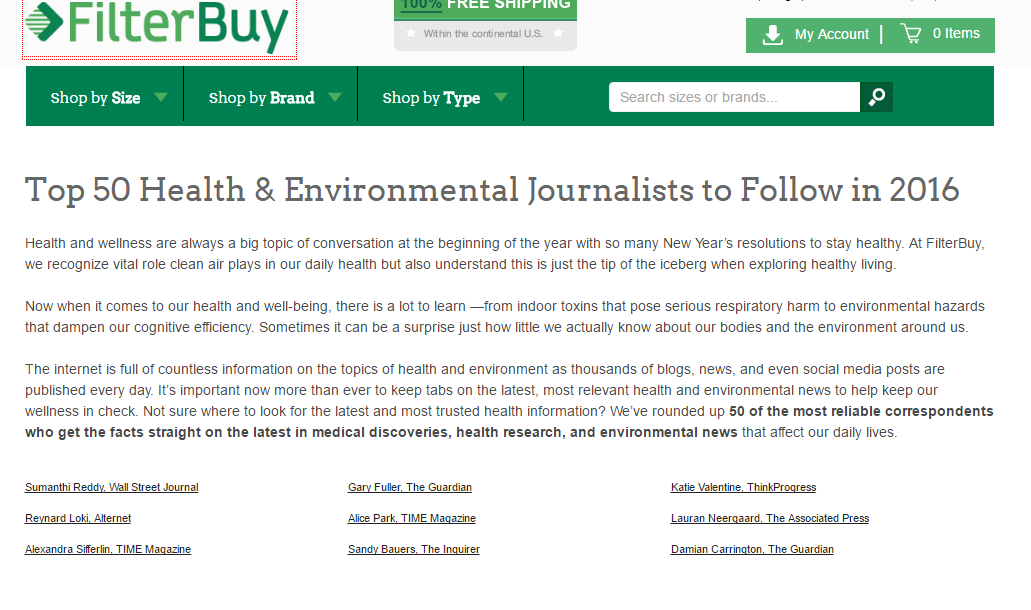

Hi [ NAME ],
I’m Venchito Tampon from [ BRAND NAME ]. We recently published a post featuring the top [ NICHE EXPERTS]. I’m so happy to tell you that you made our list because we’ve found your blog very useful to the community.
We also included a link to your website which can help you get some visitors or readers back to your blog. Feel free to comment or share the post.
Thank you,
STEP 2: Once content is published, let those people you’ve included in your post know about it. Send them an email.
STEP 3: After two weeks, send pitches to influencers/experts asking for their expert advices on one subject matter (e.g. advice to beginner interior design experts).
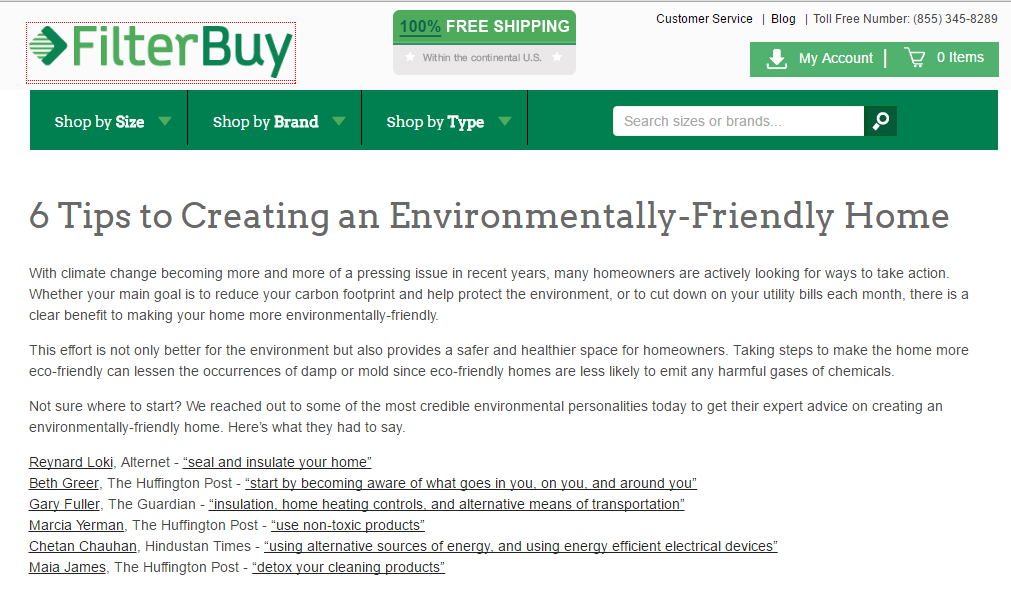

Hi [NAME],
I’m doing an expert round-up on my blog and I think many people who are new to [ TOPIC ] would love to know your answer to this question:
[ QUESTION ]
If you could send your response back by [ DATE ] as I plan to publish it on [ DATE ], that would be great. Let me know to which website you’d like us to link to.
Hoping to hear a feedback from you.
Thanks,
Venchito
STEP 4: Let your contributors know about the published crowdsourced content.
Hi [ Name ],
Hope you’re having a great week! I wanted to let you know that I just published the round-up post. Here’s the link: [ LINK ]
Feel free to share it to your friends or readers.
Thanks for contributing!
STEP 5: Create an infographic out of the expert advice content. This gives you another content asset that you can use for outreach.
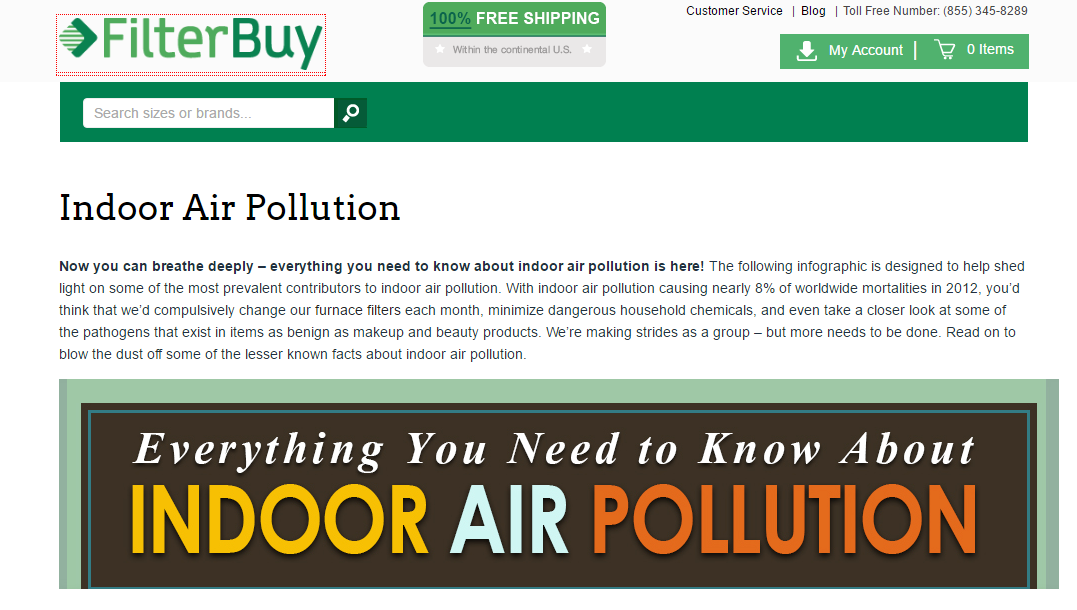

STEP 6: Promote it as much as you can, only to possible linkers – bloggers and webmasters.
Hi [ NAME ],
I came across your [ POST ]. [ TELL SOMETHING ABOUT IT]
We actually created an infographic called [ TOPIC HYPERLINKED TO THE INFOGRAPHIC PAGE ] which your readers might find it useful. [ MORE DETAILS ABOUT THE INFOGRAPHIC ].
Here are some of the findings we’d included:
[ FINDING 1]
[ FINDING 2 ]
[ FINDING 3 ]
If this finds you very interesting, I can send you a customized embed code that you can copy and paste for your blog.
I’d appreciate your feedback.
Thank you,
STEP 7: Track unlinked mentions of your content assets – x experts to follow content, round-up post and the infographic.
Hi [ NAME ],
I’m Venchito Tampon from [ BRAND NAME ] . I saw that you embedded the infographic on [ STE NAME ].
I’m reaching out to you because I couldn’t find any credit to our page or website. We actually have a copywright page for this. I’m requesting you to add a link somewhere in your introductory post or below the infographic.
Thank you,
OTHER USEFUL ECOMMERCE RESOURCES:
- Shopify blog
- Hubspot’s eCommerce blog
- Ahrefs’ post on eCommerce SEO
- 37 M-commerce Statistics & Trends in 2019
If you liked this post, you can subscribe to the email opt-in at the top or at the right sidebar and follow me on Twitter @venchito14.
Have We Been Helpful?
Want to take your eCommerce link building to the next level – — but don’t know where to start, and are feeling overwhelmed by this post.
We are here to help you. SharpRocket is a team of link building specialists who love building high quality links.
To learn more about how we can help, take a look at the services we offer and results we got for our clients.
How to Speed Link Prospecting Through Observations
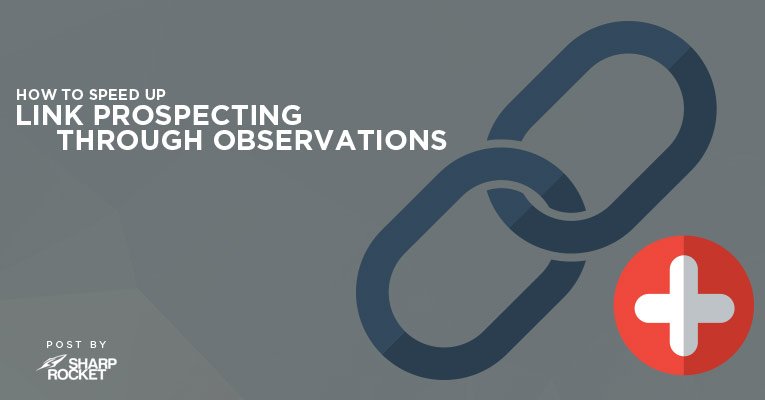

There are many viable guides and how-to’s in link prospecting from different SEO experts. Some techniques are learned simply through your own observations from campaigns that you have handled. We, at SharpRocket, incorporate those observations from our own personal experiences which helped us be more productive in building links.
LISTING DOWN LINK SIMILARITIES
Most bloggers use the same terms in creating links for their pages. For example, in creating a resource page, the commonly used terms are domain.com/niche-resources; domain.com/resources.php; domain.com/links.html. Therefore, we can use google queries such as inurl:niche-resources or inurl:links.html. The search engine result will give us a list of resource pages according to the niche we are looking for. Below are other search queries you can use to find additional prospects for your client which we personally use:
- resources/links
- resource-guide
- useful-links
- useful-resources
- niche-resources
- recommended-resources
Though not all search qeries such as resources.php, links.html, or useful-links, provide resources that are relevant to the client’s industry, it is advisable to add a distinction which is based on the client’s niche to narrow down the results in the Search Engine Results Page (SERP), e.g. inurl:useful-links “niche”. Google will then provide you results based on the keyword you used which is more applicable to your campaign.
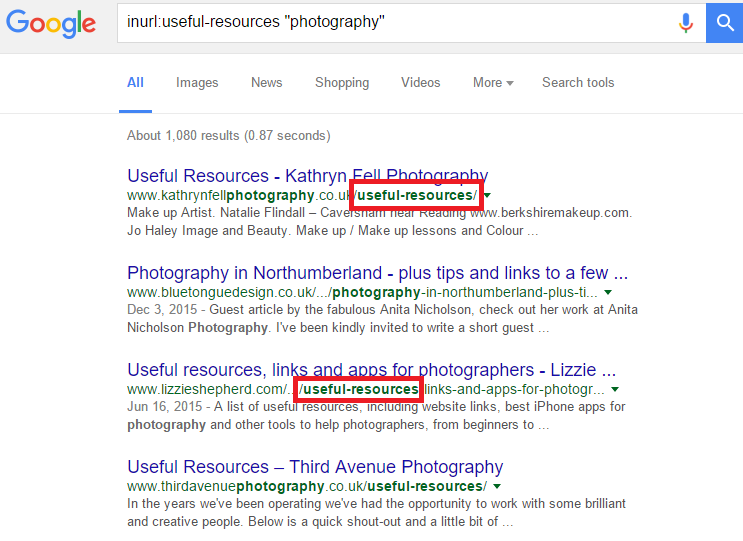

Pro Tip: Just be creative with the words you use along with being observant. If you have a hunch or an idea which you think can be helpful, it wouldn’t hurt to try experimenting on it. Who knows, you might even be able to discover other useful techniques you can use to further enhance your link building skills. Don’t forget to check out the links on the resource page you found, for it may redirect you to a new prospect opportunity which you have not seen through the list that Google displayed.
UTILIZING COUNTRY DOMAIN EXTENSIONS
As you may have noticed, some domains do not always end in .com, .org, or .edu, and other web addresses use different domain extensions depending on the country in which their website is being hosted (e.g. “.au” which is hosted in Australia or “.ca” which is hosted in Canada). By using these domain extensions you can narrow down the results based on your preferred country or target audience. You can use the advance search operator “inurl” followed by the country domain extension that you want to focus on (e.g. inurl:.ca). You can also add a distinction to make the search query more precise. If you are looking for guides or resources you can use to enhance your skills in photography, you can use inurl:.ca/photography-resources. Google will then give you a list of photography resource pages with the country domain of Canada.
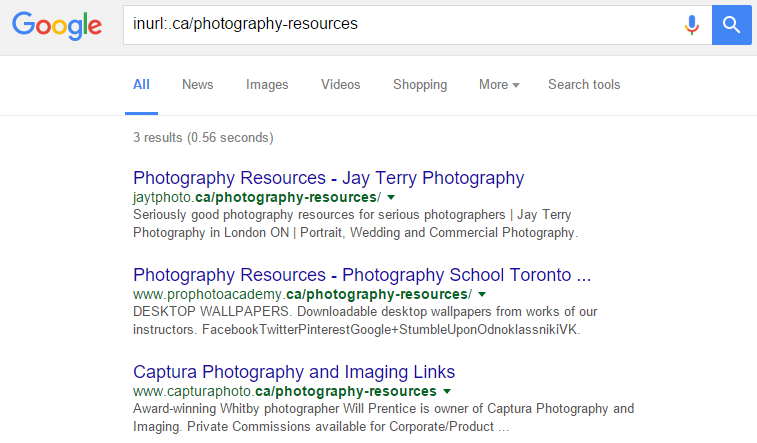

Pro Tip: You can use these techniques in any niche or industry you wish to do research on. However, if you don’t have a specific country you would like to focus on, searching for link targets that end with .com first is most recommended because it is the most recognizable and highly used domain extension. You can then use the other country domain extension of your preference to gain new prospect opportunities.
You can visit this Webopedia guide for a complete list of countries and their domain extensions.
IDENTIFY COMPANY BLOGS THROUGH SERPS
By taking notice of the Search Engine Results Page (SERP), we can also pinpoint if the link is a company website or a personal blog. Though not all domain names and punctuation marks are 100% accurate, it can somehow lessen our time in checking each link just to see if it is a company website. Here are some examples:
![]()
![]()
The above query will display links that have the key words “light” and “bulb” in the title of the article . One result has the punctuation mark called pipe or vertical bar on the page title. It was followed by the domain name “1000Bulbs.com”. Here, we can be quite sure that it is a company website because the page url was also mentioned in the title.


Clicking the link will redirect you to the webpage.
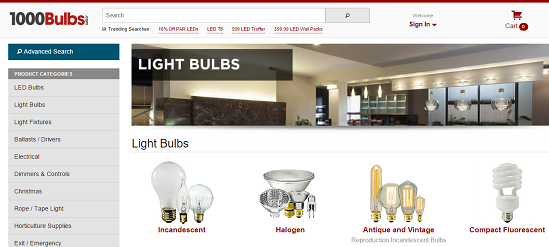

Another punctuation mark used in identifying a company website is hyphen or dash. As you can see, the domain name which is the brand name of the company is included in the page title after the hyphen. Most of the time, em dash or the long dash is used.


Lastly, the punctuation mark colon. The difference of this punctuation mark from the hyphen and vertical bar is that you can instantly notice it at the beginning of the page title. The brand name is cited first followed by the colon and page title of the article.


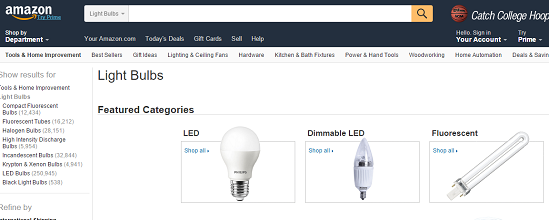

We can distinguish company websites through these punctuation marks located at the page title. Just a little note, not all sites that uses hyphen, vertical bar, and colon in the page title are companies. Some content creators tend to do that as well.
MORE OBSERVATIONS, FASTER PROSPECTING
Observational learning is a must in link prospecting. It helps us maximize the use of Google queries and lessen our time in clicking unnecessary links. Simple terms, domain names and symbols might have deeper meaning. This is why we have to keep our eyes open and our minds sharp. Noticing terms you don’t usually use but is mentioned in the client’s industry can be used as keywords for a broader research. Checking on how domain names are created by bloggers can give us a better chance at generating a higher number of results. We just have to be adamant about making observation a priority.
How to Make Your Link Building Effective
The value of every marketing practice lies on its ability to generate results. Same goes to link building.
Engagement, social shares, referral visits and assisted conversions are some key results of an effective link building campaign.
However, there are websites that don’t necessarily require links to become major sections of the brand’s deliverables, as those sites could easily gain its own recognition (visits and conversions) using any of the following simple methods:
- Fixing the basic on-page elements of key pages, as this is very beneficial for a site to let Google understand the context or theme of every individual webpage as well as the overall domain.
- Offline marketing activities brought into natural online engagements could drive additional direct visits to the site, particularly if the brand has a huge following in the offline scene (brand sponsorship and appearance in industry seminars/conferences).
- Websites that have diversified sources of visits/conversions (e.g. social, email, etc..) doesn’t require much of link building work, especially if their main visit-driving source isn’t organic.
At SharpRocket, we choose the clients that we work with. Here are some types of potential clients that we don’t usually entertain:
- Clients whose websites that don’t have strong on-page elements won’t see much results in their organic traffic, even if we’ve built multiple links to their pages (improper keyword targeting, usability, coding issues, etc..).
- Clients in industries that have low number of niche blogs and couldn’t tap other sectors because of its narrowed site/brand theme.
- Clients who are primarily interested in building contextual links with commercial-focused anchor texts.
- Clients whose main goal is to solely rank its homepage with no other interests to build links to its non-promotional pages.
- Clients in illegal industries (gambling, porn/adult, etc..).
I firmly believe that link development should be an investment to every company, SEO agency and direct client, as they have to spend at least 6 months in order to see improvements in their organic traffic which will later on translate to conversions.
We’ve been working on several clients coming various industries, some invested in long term. Others just want to test the results for one month.
Below is the screenshot of the organic traffic of one of our clients (we’ve signed an NDA agreement so I can’t share the site’s URL, sorry guys!).
The client is in the beauty niche and had outsourced their link building work to us for 6 months.
Another graph is from a legal client whom we’ve helped to build links to its key pages from customer-based blogs (parenting and finance).
Today, I’ll be sharing to you actionable tips on how to make your link building work more effective for your brand.
-
Set up valuable metrics
With so many big SEO tools out there, most search marketers couldn’t easily identify which metrics are worth looking at, and are worth to use for their site’s or clients’ link building campaigns.
These metrics shouldn’t just help set the benchmark for reporting purposes, but should also bring the real value to the clients.
At SharpRocket, we define metrics that best suit our clients based on what they need as a brand
We’ve realized that we can’t just rely on one metric, as using one SEO tool to qualify a certain link prospect isn’t a wise decision. No SEO tool is perfect.
There are websites in various industries that have high Domain Authority, but receive low search traffic every month (~100 to ~200 organic visits per month).
Journey to Millions (DA 43)
Money Reasons (DA 43)
Take a look at this website (Happy Schools). It has Domain Authority (DA) of 29 but is earning ~20,000 search traffic every month.
It’s up to what you and your client had agreed on the metrics, but as a company, it is better to understand and apply the real metrics that can certainly give real value to your clients.
-
Target practical pages for better ROI in outreach
We’ve been contemplating recently on what made some of our projects perform better than other projects (with respect to the verticals they’re in, as some niches like fashion, travel and finance have higher response rates than others).
One thing we’ve drawn from our data is the higher link ROI in practical pages (how to’s, tips, tricks, strategies and related terms) than theory-based and news type pages (what, when, etc..).
The reason behind this is that bloggers/webmasters could easily insert an additional resources or mention a post in a practical type of page, compared to giving you a link from a “what” or “when” page as it would take more time in contextual editing.
Here’s one sample of data from one of our campaigns (marketing vertical).
So if you’re targeting existing pages/posts of blogs as potential link opportunities, then it would be better for you to find practical themes than simply any type of blog posts.
Practical pages could be any of the following:
- List of “Topic X”
- Getting, attracting, learning “Topic X”
- Ultimate guide, definitive guide or minimalist guide to “Topic X”
- “Topic X” strategy, techniques, tips or tricks
- Solutions to “Topic X”
- Ways to improve, gain or other related terms “Topic X”
- Top 10 “Topic X” resources
- “Topic X” ideas to use
-
Identify linking audiences through topic analysis
When you executed a plan for a site’s link development campaign, you already know its target audience by looking at the site’s products/services pages or simply asking your client/manager/CEO or any person in charge in the overall management of your website.
However, when you use the site’s customer base as your search query, you are not guaranteed that the bloggers/webmasters of pages revealed from that particular keyword phrase are highly linkable audiences.
One of our client projects is working in the online store/sales niche, where we previously targeted verticals: ecommerce and social media.
After one month, we’ve tested another batch of prospects to target a related niche – money making - not primarily the target audience but is still part of the customer base of the brand (and was approved by the client himself).
An increase of 9% in the placement rates from last month’s link acquisition rate of 13%, which we couldn’t achieve if we would be focusing on plain ecommerce and social media topics.
The point here is that as a link developer, you’ve got to strategize not only in thinking of additional search queries for link prospecting and creating email templates for blogger outreach, but in analyzing the right theme/topic/keyword that have high linking potentials.
If you're looking for an agency to outsource your link building work, you can contact us for an inquiry.
7 Penguin Proof Link Building Tips
In 2012, after Google released its link-spam filter Penguin, many businesses started cleaning up webspam signals in their backlink profiles to be able to recover from the tragic site demotion by Google (which is just a product of marketers/bloggers’ unnatural link practices).
However, not all businesses had fully recovered from their previous downfall due to logical reasons, such as:
- The website had other technical issues that pulled it down to the bottom of rankings.
- Waiting for Google to refresh/re-ran its algorithm which will release sites that had previous link-related issues but were fixed thoroughly.
- The website’s good rankings are highly dependent on the power of links to move it up to higher rankings – the site is obviously not deserved to rank.
Probably this year Google will release its algorithm refresh, which can help sites that have already cleaned up their link profiles and demote websites with newly discovered spam.
Whether it’s a Google Penguin refresh or update that is coming this month (or probably next month), search marketers, particularly those who are specialists in link development (link builder, link marketing consultants, etc..) should be able to constantly create quality controls in their link building processes/activities/tasks in order to sustain and grow their sites’ backlinks.
Link audit is one example of a necessary quality control process in link development.
The basic foundation of a link audit system, which are also possible elements of Google Penguin filter are the following:
- Link source quality. This is best identified by looking at spammy and irrelevant sites, link networks, sites that contain artificial links and blogs with content that have low user activity.
- Ratio of the number of good vs bad links.
- Thematic relevance of linking sites/domains.
- Amount of links with exact match anchor texts (over optimization of anchor text)
- Positions of links in the linking pages (sitewide or non-sitewide such as contextual)..
Understanding deeply the said link-centric elements could help you properly execute a link audit process and/or build a link building campaign that can stand against any future Google Penguin updates.
In this post, I’ll be sharing to you 7 Penguin-proof link building tips.
1. Proper prospecting with advanced search operators
Link prospecting is the initial phase in link development where you collect a certain amount of link opportunities (blogs, sites, web communities, etc..) based on the industry’s competition level and demand.
One common way to gather a bunch of link targets is by using advanced search operators.
Search operators are phrases that can be added to searches to help narrow down the search results. They are highly useful tools in finding highly targeted domains/pages in search, as you can easily filter the pages based on opportunity types (blogs, .edu, .org, etc..) and based on thematic relevance.
For a full list of advanced search operators, you can check out this resource page on Google Guide.
In link development, there are only certain search operators that can help you pre-qualify backlink prospects in the link prospecting phase and they are as follows:
- intitle
- inurl
- site
- related
Let’s dig into each of these search tools.
intitle
The advanced search operator: intitle helps qualify pages based on thematic relevance.
On-page keywords (“swimming”) would only reveal pages that have the word, “swimming” in the body/context of the page, whereas if the intitle is added to that keyword, you would see topically-relevant pages with meta title “swimming”.
Bloggers or content creators would normally use the main topic of the article as the meta-title - giving us an idea that the whole page is highly relevant to the brand’s page/content.
Proper intitle: usage also helps you find specific audience types (swimmers, fitness instructors, etc..).
inurl
This advanced search operator is primarily used when looking for opportunity type footprints that only occur in the urls of pages.
You would normally see inurl usage in broken link building when finding links/resource pages that are relevant to the site’s content (e.g. inurl:links.html “driving safety” to find backlink prospects for a “senior’s guide to driving” content asset).
site:
Site search operator should basically be used to filter the page results based on TLDs (.us, .edu, .org, .gov, etc.).
This allows you to prioritize types of audience that you’re looking for. For instance, you want an audience of highly respected dentists in your local city, you would want to use site.org to only find dentist organizations.
related:
Related search function leaves you pages that are similar to the word(s) or domain after the colon (e.g. related:digitalphilippines.net).
There are two methods that you can use related search operator:
- Finding similar websites of your brand and of your prospected site.
- Researching for synonyms of search queries/keywords.
Advanced search operators isn’t only useful in filtering pages/content in search results but also in ensuring that prospect backlinks are topically relevant to the brand /site you want to build links to.
2. Build 10x content assets to attract editorial links
Rand Fishkin shared the principle of 10x content in one of his Whiteboard Fridays at Moz. He provided actionable tips on how to create or improve a content piece to make it 10 times greater than other brands’ similar pieces.
Here are some of his useful points:
- Examine the quality of content piece based on its relevance to the search query – does your content answers a specific question by the user?
- Improve your content in terms of site speed, mobile friendliness, rendering, layout, navigation and design quality – identify industry benchmarks regarding those technical sides to check the content’s performance on the web.
- Thoroughness and details of the information provided in the content (credible sources, backed up with data, etc..).
There are a few reasons why I believe producing 10x content is a viable tactic in ensuring a Penguin proof link building campaign.
- Data-driven and expertly-made content have higher possibilities of earning editorial links from bloggers and researchers who’ll be referencing useful references in their works (blog content). This will help diversify the site’s link profile, as you would have no control on the elements of the links earned (anchor texts, referring pages, link placements, etc..).
- A 10x content asset produces hard to replicate links from websites/blogs only in primary industry and semi-niches. This maintains the thematic relevance of the site/content towards other pages, as you won’t get any irrelevant mentions/links if they are actually earned.
For the past two years, I’ve been constantly delivering quality content assets (10x content) on my blog that somehow marked my expertise in the link building scene.
Here are a few examples of content pieces that gained some traction in the past even up to now, as they have been ranking highly in search results for multiple keyword phrases.
43 Experts Share Their Most Actionable Link Building Tip
This post from 2013 is a compilation of different link building strategies, tactics, processes and tips coming from the well-known link building experts in the world.
It currently received 45 linking root domains and had been earning several mentions in blog roundups, interviews and forums.
One example of a forum mention is from this blog of Matthew Woodward, where someone had reference the 10x content to support his answer to the user’s question.
One benefit of producing 10x content piece is its ability to amplify links and social shares even after seasonal periods (weeks/months after publication).
The said linkable asset earned an authority link from Neil Patel’s blog in his latest post on building powerful links with images.
Further Reading: 24 Untapped Ways to Get Ideas for Your Next Blog Post
This 2014 blog post caters to the huge audience of blogging (blogging newbies and practitioners) on the topic of blog ideation.
Few weeks after it was published on my website, it earned several contextual links (first tier links) from niche-specific posts of bloggers in the local and international scene.
Given that linking pages have been receiving direct and organic visits, the likelihood of getting potential linkers to mention the linking page from their own content as well as linking to my site’s content piece becomes higher.
Up until now, my blog ideation post is still receiving social shares and high quality backlinks from blogging-centric sites . A good example of this is a referential link from Blogelina, an authoritative website in the blogging industry.
One advantage of a link earning activity of 10x content (or content pillars) is its ability to diversify the site’s link profile based on the location of the links on linking pages (or commonly referred as, “link placement”).
Given that links are earned, there would be a variety of link placements. Some links are located at the bottom of the content. Others would come the footer section of websites or best, links are located on the body of the page – contextual.
Google has an idea of where each backlink is located on the page. This allows them to target a lot of websites that have backlinks from a single page location (e.g. footer or widget links). On other behalf, Google also evaluates links placed higher up in a HTML code as powerful votes to the page it is referring to, for the obvious reason that they are likely editorial and are actually earned by the brand.
Producing 10x content assets on the blog doesn’t just help the site to attract hard to replicate links from niche relevant pages but also ensures that links earned/built are indeed, beneficial to the page’s performance on search (they add value in terms of relevance and authority).
Here are some useful resources on building 10x content assets:
- Content Marketing Data That Moves the Needle
- Testing The Skyscraper Technique [Case Study]
- Creating and Promoting Link Magnet Asset Pages
When you're in active link building campaign it is important to know how and where to put the right anchor text so you won't harm your rankings, read more about it here.
3. Balance recency-based link building tactics
For the past several years, we’ve seen and heard various link building tactics that had been a common toolset for search marketing agencies today.
But the real question stands, is there any link building that would remain effective after a decade of use?
Link diversity is the key in content marketing, even in at using tactics to acquire links from industry sites.
There are two basic types of content based on the recency of the acquisition of links: new content and existing content.
Broken link building is a solid link acquisition tactic that simply involves reaching out to webmasters about broken links identified on their existing pages, with the hope of getting those defunct links replaced with links to the site’s content/page.
Guest blogging, alternatively, is focused on writing new articles with links placed in the, submitted to editors of blogs for publication review and hoping to build links from those content pieces when published in due time.
These two powerful link development tactics have different target pages, broken link building is focused on existing content whereas guest blogging targets new/dynamic pages of the site.
Having a moderated execution on these two tactics gives you a balanced link profile.
You can also use the following link building tactics to diversify your site’s link profile based on the recency of target link pages:
- Reach out to webmasters and content creators who mentioned any content from your brand (images, stories, products/services, content assets, etc..) and ask to give your brand credits from their pages.
- Integrate online marketing activities in your offline events (sponsorship, speaking, participation, etc..) by getting them share your latest content, providing feedback about it and/or covering your activity in their future posts (reference).
- Create a landing page for discounts/coupons/freebies of your products/services and make it visible to your target audience by doing a press release / blogger outreach campaign (reference).
4. Use different footprints for link prospecting
Link prospecting footprints are patterns in search phase that gives Google an idea on the method and progress of the brand’s link development campaign.
Building a database of backlink targets with the same footprint puts the website at an unnecessary risk.
Don’t run a massive link building campaign with the same, common and basic footprints (e.g. inurl:guest-post to overall list of prospects).
You can use other niche search engines to build a spreadsheet of link targets (not just using Google in most cases). Below are some examples.
- Finding industry bloggers on Twitter by simply doing a social search for “industry blog” OR “industry blogger”.
- Using related search operator to easily find similar blogs of your listed link prospect(s).
- Researching for niche blogs from blog search engines like Blogsearchengine.org.
Other useful resources:
- Big Prospecting with Authority Anchors: a Process Guide
- 30 Free SEO Tools and How to Use Them for Link Prospecting
5. Diversify link type through image-based link building
A variety of link types is not a big issue in link diversity. However, you have to get a feel of what your top ranking competitors are at.
If their ratios of image to text links are different from your site’s link profile, then you should be concerned on switching some of your image-based links to text ones, especially if all advertisements are linked through images.
Here are some ways to build image-based links using existing branded content:
- Determine pages that embedded your brand logo as part of other websites’ sponsorship opportunities, media/press activities (e.g. interview) and other offline turned to online marketing activities. Reach out to webmasters and ask to replace those image links with branded text ones.
- Look for industry related blogs that published copies of your infographic/visual content and tell them to link to your page using text-based approach.
Master image-based link building using the following references:
6. Create more brand awareness by targeting semi-relevant niches
Building links nowadays from semi-relevant niches is an effective way to improve your domain and brand authority, as you can increase the chances of getting new subscribers and readers as well as followers from other industries aside from your primary target group
For instance, if your company is selling wedding attires, you won’t just aim to target links from wedding blogs but you can also tap relationship and fashion blogs, which are considered semi-relevant niches.
Site relevance is an important factor that Google uses to detect spam websites/blogs that have several links coming from irrelevant verticals.
Aside from spam avoidance, targeting link prospects from semi-relevant niches also bring referral traffic to the site that could potentially convert to customers/clients.
7. Target appropriate pages in outreach
One of the simplest ways to break down your backlinks by target page is through seeing the ratio of home page links to deep links.
As you develop links over time, you don’t want to have all links go to your home page, as it would signal to Google that is the only essential and worthy of ranking page in your site.
Having most of your links point to your deep pages allows you to have a balanced link profile in terms of target page(s).
You can properly diversify your links by measuring via the Deep Link Ratio: # of deep links over # of total links.
You can calculate this by getting the total number of links using your favorite link building tool (I prefer you only look at referring domains instead of seeing the number of total links – since most of them are sitewides). Then get the number of homepage links and subtract it from your total # of referring domains to get the # of deep links.
A few practical tips to increase your number of deep links:
- When performing link acquisition activities, it is best to refer your most relevant deep page to a potential linker as it won’t only balance your Deep Link ratio, but gives more authority/link value to your domain.
- Invest in building branded links through interviews and round-ups that could link to your site’s branded pages (about us/our team, company, services, etc..).
- Create expertly-made content on a regular basis that has unique value proposition and could attract editorial links from industry bloggers.
If you're looking for a link building service for your company, you can contact us for inquiry.
Link Building for Agency Level SEO
Links are still an important ranking factor in search algorithm, being considered as the most influential matter in search rankings (on a domain-level and page-level bases).
Alongside the rise for competition in search performance is the increase in demand for high quality links from blogs/sites in relevant industries.
Coming from a link building agency (Hyperlynx Media owned by Jon Cooper) to starting my own link development company (SharpRocket), I’ve seen hundreds of companies from different verticals investing in link building for the sole purpose of seeing an improved organic traffic of their company websites.


A few other reasons why link development is a good investment for businesses (whether they are from small to medium scale or Fortune 500):
- Links serve as a powerful branding tool to make websites more visible on high traffic publication websites.
- Links can drive potential customers and clients to the website – making it as a sustainable lead generation strategy.
- Links can build powerful relationships with both non-competing brands and competitors that can pursue beneficial partnerships on both parties.
- Links are powerful signals for entity relationships that search engines and web users can use to determine if the site is authoritative and trusted (more editorial links from trusted websites could mean your website is also trusted too).
Table of Contents
Link Building Process Models
Process model refers to a structure of activity with step by step detailed instructions.
Search marketing agencies use process models to scale search engine optimization campaigns, leading to greater results – more productivity and more output.
The more clients an agency accommodates, the more it will require for the business to improve its process models or create new business processes for additional tasks/activities.
I’ve tried and tested different link building models to earn and build high quality backlinks from blogs/sites in different authority levels and industries.
Among those models are the two processes that I’ll be sharing in this post: Blogger Outreach and Linkable Asset models.
Blogger Outreach Model
Blogger outreach is a process of building connections with niche bloggers and influencers that have subtle social following and considerable authority domain levels.
Blogger outreach’s main core competency from other link building models is its ability to create new relationships without the need for creation of new linkable assets.
How to execute blogger outreach model?
The reason behind contacting bloggers with high presence in social profiles is the idea of amplification. More active and real social followers could mean more exposure for the brand being linked to from new posts.
This exposure can result to additional shares and possible contextual links from industry-specific sites who will read new articles from the blog.
You can use Followerwonk to find bloggers with average amount of social followers.
Filter the list by no relationships to only search for bloggers that don’t have any connections to your Twitter profile.
Another method to find niche bloggers is through Buzzsumo.
Type in any related industry terms in the search bar and click View Shares button to find social shares of the blog.
List all blogs in a spreadsheet and filter the list by Trustflow and Domain Authority (set a benchmark for for these two metrics).
Your next step is to send emails to bloggers and ask if you can invest in their future content assets (blog posts) where you could get a mention(s) from them.
A few examples of link investments are:
- Asking the format of their next content asset and seeing if you can invest in another content format (infographic for a long-form blog post). During publication, you can ask the blogger to mention you as one of their content partners in creating the overall content piece.
- Identifying content promotions of your brand where the blogger could largely benefit from (a link/mention from your round-up email). Eventually, bloggers would naturally link to any of your blog posts.
- Letting a designer from your team help the blogger creates unique design for his/her content piece. A photo credit with a link pointing to your site is the beneficial part in this blogger outreach tactic.
- Asking to proofread their future content work based on high quality standards such as compelling headlines and call to actions at the end of the post. Gratitude with a branded mention (your name) would be the after effect of this strategy.
You can also offer content partnerships to bloggers. This process is doable in many ways:
- Buy content from bloggers in the list who are still starting to build their own brand, since you can get a cheaper price this way than hiring industry experts to write content for you. Publish the post as a content asset on your client’s site. Links would be naturally earned from industry-specific blogs as you can absorb connections from partnered bloggers (social followers, readers and brand evangelists).
- Distribute paid content pieces as guest posts to high traffic publications and content hubs. The likelihood of getting positive approval rate from these authority blogs is high since you’ve hired industry specialists to write quality articles for you.
- Watch out for incoming links to your client’s site and to published guest posts on other relevant blogs as you can build new relationships with newly found linkers in the industry by sending them emails (thank you).
If you can build relationships with five bloggers and get high quality content from them every week, then that would be a total of 20 expertly made blog posts every month submitted to industry-specific blogs, resulting to 20 contextual links.
Linkable Asset Model
Linkable asset is any part of a website or organization that its target audience will genuinely perceive as worth citing/referencing to, as defined by Jason Acidre.
Identifying which website’s content can potentially attract relevant links to the brand can help you create a solid link development campaign for your website, since you can easily use it as forefront proposition in linker outreach.
How to Identify Linkable Assets
Here are some ways to find existing linkable content pieces of the site:
- Use Ahrefs to determine site’s top grossing pages and sort the list from highest to lowest referring domains and social shares. Exclude the homepage and site’s landing/sales pages from your list and only choose blog content as the site’s linkable assets.
- Do a Google search for [brand name] and click on the Images tab. Look at what pops up in the search results. If images are owned by the company (blog photos, logo, team members’ visuals, etc..), then upload them in Reverse Image Search to see how many websites had linked to those visual content. The number of organic websites in the Image Reverse search results is a good indicator of the content’s performance in link acquisition.
- Create a brainstorming session within your team/brand and try to find out new offline events conducted by your company. Identify newsworthy angles from those events and pitch them to high authority publications to be included in one of their news stories.
- Identify brand ambassador(s) in your client’s brand and see if they have established authorities in your niche by looking at existing online interviews, contributions to round-ups and other available media content.
- Use Google Analytics data to track pages with the high user activity (high visits, ave. time duration, etc..).
How to Improve Linkable Assets
Once you’ve identified possible linkable assets in your website, you can now start enhancing these pages for better link acquisition performance. There are many areas in the content/page that you can improve on, such as:
Call to action
One of the elements that keep visitors stay longer on the site, aside from the quality of information the page contains is call to action.
Call to action (CTA) is an instruction to the audience to provoke an immediate response, usually using an imperative verb such as "call now" or “find out more”
Writing compelling call to actions in your content pieces can help you increase the possibility of pages to earn additional social shares and inbound links.
One classic example of this is encouraging readers to embed an infographic code in their blogs to add a visual content in their existing articles.
The more enticing call-to-action (CTA) is, the better chances of earning new contextual links to your linkable asset.
You might want to check out this post by Nick Kolenda about improving copywriting skills.
Social Attraction
Social media plays a vital role in driving targeted traffic to the site’s key pages as well as opening up new link opportunities for the brand.
Linkable assets are more likely to earn new editorial links when shared multiple times on social profiles given that the more social shares a content piece acquires, the more it is perceived as informational and authoritative in a specific theme/topic.
Here are a few actionable tips driven from the statistics listed in Backlinko’s data driven guide to creating viral content:
- Add colorful visuals to your product guide. Data: Xerox found that colorful visuals made people 80% more likely to read a product guide.
- Find professional images and use them as visuals to your content. Data: An Internal Marketing Sherpa study found that pro images received 121% more Facebook shares than semi-professional photos.
- Set a featured image in your linkable asset. Data: Social shares with images get 150% more retweets on Twitter and 53% more likes on Facebook.
Length of content
Long-form content with quality information tends to perform better on search results than a 500-word blog post.
Professor Dr. Jonah Berger found that longer content was 76.8% more likely to be heavily shared (source).
The number of words (length) of content has a great impact on the page’s social performance and on its ability to be referenced by bloggers and researchers who would likely find it in search engines.
Context
Based on Searchmetrics’ ranking factors, creating more or easy content doesn’t positively affect search rankings. Search engines are moving away from focusing on single keywords to actually diving in to the so-called, “content clusters”.
Content clusters are individual topic areas that are based around keywords and industry related terms.
Content assets focused on content clusters have higher chances of getting found on different niche search terms than a keyword-specific content piece.
Since search engines already understand what the content is all about, what topics it could be tapped and industry related terms it could be connected with, there’s no reason to write articles for each and every target keyword.
How to Promote Linkable Assets
Linkable asset promotion is where you actually put all your major efforts into place.
There are a lot of online asset promotion tactics out there, but there’s only a few that are really handy and applies to almost every industry.
Here are some ways to massively promote your linkable assets:
- Become a contributor to niche-specific publications and authority blogs and reference your linkable asset from your work. Make your anchor text a call-to-action (CTA) to encourage readers to click on the link pointing to your asset page.
- Build links from resource pages across your verticals. Find any broken link in those pages and use them as your value proposition in your initial outreach (ask webmasters if they could replace non-active links with a link to your content).
- Use Topsy or Buzzsumo to find active social shares in your niche. Segment the list by the number of social followers to only find brand evangelists with large following. Try to reach out to them and let them know about your linkable asset.
- Reach out to influencers that you’ve mentioned in your content. If they’ve find your linkable asset useful for their readers/followers, they’ll definitely share it or even link to it from their blogs.
- Put more eyeballs to your linkable asset by creating sponsored Facebook ads that are targeted to local audience/interest groups.
Other Useful Resources:
- How to Get Influencers into the Hands of Influencers Who Can Help Amplify It
- Maximizing Evergreen Content to Fuel Business Sales and Marketing
- How to Build a Content Production Calendar for Earning 50 Authority Links Per Month
If you're looking for a link building service for your company, you can contact us for inquiry.
11 Link Building Strategies for Smaller Businesses
Link building will get a lot tougher these days especially for smaller brands that don’t have real capacities to compete with bigger companies in the industry because of the low amount of budget that they have.
In my experience communicating with potential clients, small companies are only willing to spend a monthly link building budget somewhere around $500 to $800 and search marketing agencies can outsource their link building work for a monthly cost ranging from $200 to $400 for each client/website.
With the price ranges above, we’ve seen a huge demand for a link building strategy that doesn’t really rely on huge budget in order to yield great results but on the value and quality of contents being produced consistently by the brand and on the approach used to promote those content assets.
And in this post, I’ll be sharing to you 11 link building strategies that can size up your links regardless of the size of your business and competition level of your industry.
Product or service development
This specific link building tactic is on top of my list since it is where the huge amount of time, money and effort should be placed in.
Constantly evolving your products/services can actually help your brand acquire natural links over time especially if you’re adding new useful features that your users care about, since the more they get tied to those product specifications, the potentials of them evangelizing your tool to their colleagues are higher.
So it is very important to keep track of newly added questions in industry forums and Q&A websites in order to gather information on the needs and wants of your potential customers. This will be the core basis of your product development strategy – user feedback.
In the recent interview with Slack’s founder, Stewart Butterfield shared a very interesting tip to win over industry competitors – make active listening a core competency.
“From the get-go, Slack made sure that users could respond to every email they received, and approached every help ticket as an opportunity to solidify loyalty and improve the service. As they listened to their ever-growing flock of users, the Slack team iterated accordingly.”, Butterfield said.
Consistent asking for user feedback will always bring new ideas to the table, which will not only solidify the brand’s core USP (unique selling proposition) but will also help the website acquire voluntary-given links from bloggers, influencers and corporate site owners.
I remember the early days of URL Profiler where its founders Garett Brown and Patrick Hathaway were asking for suggestions/feedbacks for their newly launched tech product. They got in touch with a handful of search marketers (especially those who’re actively working on content development and link building campaigns for several clients) in order to know the pros and cons of using the product for the said purposes (link building and content dev).
I used the tool, exchanged ideas with Garett and eventually evangelized the software on this link building blog.
Imagine if you have 20 different suggestions from like-minded bloggers in your industry. That’s a solid list of product development ideas that will not just improve your product features but will get your product or your site’s internal pages to earn links from bloggers/influencers who’ve been involved in the ideation of the product development.
You can add that unique angle (product feature suggestion) to your link building pitch in order to increase your chances of getting more responses and possibly editorial links. Given that the more you involve your target users to your business operations, the more they become overwhelm and attach to your brand, especially if their suggestion(s) has/have been considered and used in the product development.
Another way to build links with product development is to invest in creating free web-based tools.
Look at Traffic Travis. It is a free SEO software developed by Affilorama, which has been very popular in the internet marketing industry not only because of its highly functional attributes but on its free access.
For service-centered agencies, developing free web products is a good investment for branding and link acquisition.
One good example of this is Content Harmony’s free ShareMetric Chrome extension.
Given that the tool is freely available, industry bloggers and influencers can easily test it and share to their readers and followers by linking to the Chrome’s page and/or sharing it on social platforms, which will certainly promote the product to other untapped users.
Link acquisition is possible using this approach since the brand can simply reclaim the backlinks by asking existing linkers of the tool to link to the website’s tool page instead of linking to the Chrome extension content.
Word of mouth and referral marketing are best sources of link opportunities since bloggers and webmasters will naturally mention the page/tool from their blogs with no to little efforts on outreach.
Social prospecting
Social platforms has been a common medium used for link acquisition and content development these days since the competitive insights that content marketers can draw from it can really bring improvements to content marketing activities (content ideation, link prospecting, proper user targeting, etc..)
There are gazillion ways to generate content ideas using social media, and one of them is to create Twitter lists of bloggers/influencers from your niche and from other related industries.
The lists are useful for extracting questions, information and industry trends from engaged Twitter users (conversations, favorites, retweets), which can be the basis for improving the brand’s existing assets and brainstorming for new content pieces in the future.
Aside from generating content themes and topics, social media is also a handy tool in promoting one’s content to a set group of influencers and bloggers.
You can use the new Topsy extractor tool by URL profiler to find influencers who've shared similar content of your brand (either content from competitors or non-competitors).
There are two things you can do with Topsy extractor:
- Find influencers who have shared the top pages in your industry and include them to your Twitter list. Spend at least 5 minutes every week to see their latest status updates and conversations and use that as your basis for content ideation.
- Create an outreach database listing down all influential social sharers, which you can later on pitch to share your content (if it is highly resourceful, they wouldn’t bother to link to it).
The marketing flywheel will continuously move the moment the content was massively shared on social networks, since bloggers and influencers who would have seen the page and find it useful will again share the content to their followers and visitors or even link to it from their own websites.
Even after weeks or months of publish, the page would still attract organic social shares and editorial links from researchers and bloggers who’re looking for references for their own works.
My older post on content promotion strategies is a good example of this link building strategy (social prospecting) because up until now, the content has been attracting social shares almost every day.
Link intersection
Understanding the linking behavior in a certain niche is still one of the effective ways to build authoritative backlinks that doesn’t rely heavily on the niche competition and/or difficulty level of the industry, but on the quality of crafted content and blogger relationships used to support the page.
One link building principle that you can take advantage of is link intersection, which is basically finding domains or pages that have intersected or linked to at least three resources that are similar to your content.
For this link building strategy, you can use Citation Labs citation tool to automatically generate a report of links with corresponding number of occurrences.
This method is useful when prioritizing your outreach activity for a long list of linking pages, since you can actually get an insight if there’s a high potential that a certain page will link to your content (when it is linked to other multiple resources as well).
You can use the tool in any of the following link building tactics:
- See which pages and domains are actively and consistently linking to at least two of your competitors’ sites/pages given that if they’ve linked to those sites, they can also link to your content.
- Find listing pages (manufacturers/suppliers) that have high potentials of linking to your content which will primarily be based on the number of times your competitors’ sites were included.
- Determine local/international media outlets that previously mentioned at least two of your competitors. Once you’ve picked up those news sites, find a way to interact with their journalists or reporters to get some coverage for your brand.
There are other ways to execute link intersection in your link building strategy, and I might write a post on that topic alone.
Strategic blogging
Blogging is a powerful marketing tool because of its ability to instantly connect the brand with its target audience in a non-promotional way and being able to capture their interests – making them loyal subscribers and brand evangelists.
Aside from its connection ability, blogging can help speed up link acquisition by constantly producing high quality blog posts that are comprehensive and useful enough to be linked from relevant blog posts (old and newly published).
Part of maximizing the linking potential of a certain content /page is making sure that it can constantly be found in the search results by optimizing the page for basic on site optimization.
Keyword research is a basic yet vital activity in search engine optimization. It helps the search engines understand what the page is all about by including industry keywords and phrases that specifically defines the purpose of the page.
When it comes to keyword research for blogs, targeting long tail keywords is the best approach to increase the odds of ranking for multiple industry phrases in search results, which if successfully done, will definitely bring newly targeted visitors to the content over time.
Here are a few tools to consider when executing a keyword research process:
- Google Keyword Planner (an instructional guide here)
- Keywordtool.io
- Google suggest
You can also check out this recent webinar by Nick Eubanks about competitive keyword research for search engine optimization.
Keyword research that is accompanied with basic on site optimization and tactical content creation will certainly make the blogging process much easier and effective in getting more targeted traffic from search engines.
Roel Manarang shared a comprehensive case study on how the combined efforts of optimization, content and keyword research will make a newly launched blog successful in earning 1000 visits a day.
Here are some more useful tips that you can immediately apply to your blog to size up links and blog traffic:
- Invest in creating cost-effective content pieces like crowdsourced content and curated page wherein the efforts put into these pieces will pay off once they’ve captured the attention of potential linkers in the industry.
- Update older webpages by optimizing them for timely keyword phrases (e.g. best practices for 2015) in order to improve their ability to rank for long tail keywords in search results (in which a a constant search traffic is assumed).
- Invite bloggers to become regular contributors for your blog in exchange for monetary and/or non-monetary benefits (free access to premium products, social media exposure, lead generation opportunity through email, etc..).
You can read this post on increasing blog traffic which was just updated by Rand Fishkin last year.
Second-tier link building for long term traffic generators
A proper tier link building process is building second layer of linking pages that’ll support the initial set of linking domains, with the mindset of driving targeted traffic to the site’s internal pages.
To start with, it is very important to identify your brand’s traffic generators by looking at your site’s referral acquisition data.
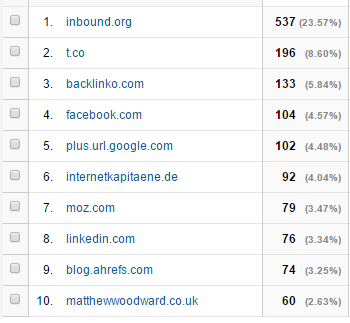

The higher visits and potential revenue they generate for your business, the more you should focus on building links to them.
There are several non-labor intensive methods that you can use to build second-tier links to the first linking pages of your website, including:
- Cite your initial linking page as a resource when participating in industry forums and Q&A websites.
- Produce the right content pieces on other blogs and link to your initial linking pages with proper contextual relevancy (ensure that those pages are relevant to your contributed content).
- Mention pages that have linked to your website in your interviews and guest appearances on other websites (podcasts, videos, etc..) since there will be opportunities to build links from those participated content (i.e. an end of the post list of tools/resources you’ve mentioned in the podcast).
Build exclusive local partnerships
The best element of earning highly authoritative links these days is relationship. Building the foundation of relationships with every thematic local brand through various online efforts that benefits both parties will definitely create a huge impact to the website’s branding and to its link acquisition strategy.
In the recent Whiteboard Friday by Rand Fishkin, he shared a handful of ways on how a brand can maximize the value of advertisements to yield SEO value:
- Get direct traffic through ads on blogs, forums, niche websites, or news/media sites.
- Participate in conferences and events by becoming a corporate sponsor. Give creative giveaways to your audience (e.g. free wifi).
- Choose outdoor/TV/radio/print advertising activity that can generate the highest business value to your brand.
In all of these platforms, a small business is more likely to invest in the first platform – blogs/forums/niche sites advertising.
Given that visits are targeted to a specific group of users/customers (since you are able to choose which website you want to advertise in), the link acquisition rate using this approach is higher, more especially if the content being promoted is highly resourceful to the target community.
Other local activities your small business can start executing today include:
- Creating a local guide such as an events calendar for a certain location/city and start distributing the page to your local partners.
- Provide testimonials for other local businesses whom you’ve partnered with in the past. It’s a give and take approach (you’ll get reviews for your company as well afterwards).
- Speak at local events in your town and in your universities or colleges near you. Start by engaging with local organizers visible in Meetup.
Local partnerships will take your small business into many places. By simply connecting with other brands, you start to widen your brand reach and being able to build alliances that are sustainable and beneficial in the long run.
Create link building machines
Link building machine is a term used for content assets that guarantee a constant attraction of natural links both from authority websites and mid-tier blogs.
With link building machine, you maximize your efforts and focus on creating and/or improving a single content piece one at a time.
Your aim is to build multiple of this machine type in order to increase your branded authority in your industry and being able to invite other related brands for corporate partnerships or alliances.
For small businesses, here are a few link building machine ideas that you can initially create for your website:
- Compile all branded images (pictures of local events, staff members, office locations, etc..) into one solid page and make it more visible to your audience by linking to it internally from your homepage.
- Start providing online coupons to your potential customers and give discounts to those who would be able to share/promote your coupon page on their own blogs/sites.
- Create your own referral or affiliate program simply by publishing a page that invites your visitors to refer your services/products to their readers and followers in exchange for a monetary payment and/or a premium access to your products.
Get premium product reviews
Product reviews are useful for brand recognition and authority, since the more reviews you acquire from industry blogs, the more branded searches you’ll get for your website every single month.
Inviting industry bloggers to write a review about your product is a challenging activity these days, particularly for brands that don’t have bigger budget to invest in paying their future promoters.
For small business owners, you can simply spend time in searching for prospect bloggers who have a history of writing product reviews and are targeting the same group of users as yours. Find those bloggers in any of the following product review platforms:
Engage with these bloggers and offer a long term partnership opportunity wherein they can generate regular passive income from your company through affiliates or referrals. Establishing relationships with product review writers will pay off in the long run since they can eventually evangelize your product without the need to pay them for their works (they will be accustomed/attached to your brand’s offerings and benefits).
Create a linkable jobs page
Every small business has a recruitment process whether it is assigned to a specific person or the CEO of the company or the Director himself does the hiring process.
For corporate websites, jobs page is an important tool to acquire talented and skilled workers who’re very interested to work for the company and has a good background of what the business’ offer, vision and mission are all about.
Create a jobs page that bloggers would likely to link to it because of the completeness and accuracy of the qualifications of applicant included in the page.
This jobs page of SEO Hacker is an example of a linkable jobs page. It is currently ranking for the keyword phrase, “SEO jobs Philippines”.
Distribute business assets to external local web properties
Content pieces crafted by your local staff can be distributed to external web properties in order to increase their visibility and become channels of link acquisition for your website.
There are tons of external properties on the web that have opportunities to add direct backlinks to your website. To name a few:
- Business profiles. Make the company details complete to avoid removing your company from the list because of its spam-looking profile.
- Video distribution sites like Vimeo. Add local promotional videos of your company and share video links on social profiles to get clicks on them.
- User generated sites like Slideshare. Invest in building a well-designed portfolio of contents you’ve presented in offline events, since this can somehow drive potential revenue to your business (e.g. Sean Si’s presentation portfolio).
- Podcast directories. If your site is involved in audio or podcast activities, submit these contents to podcast directory sites to build authority and audience in that particular platform.
Collect all available resources of your company and maximize their visibility potentials by submitting them to external web properties.
Engagement marketing
Engagement marketing is a free way to build links in this age of digital marketing, given that you don’t actually have to invest a huge amount of money to start with, just an hour every week is enough to start connecting with like-minded people in your industry.
Send customized products to bloggers and influencers who had engaged with your brand.
James Norquay from Prosperity Media received a set of cupcakes from the guys at Cupcakes at All Occasions. This gotten James’ attention and certainly help him strengthen his relationship with the cupcakes company.
Another great example of engagement marketing is this letter of appreciation from the Wordstream team, which is headed by Larry Kim.
There are still other ways to associate yourself with other brands through minimal and non-expensive engagement methods.
Here you go. These are the 11 link building strategies you can easily implement to your small business website. Let me know in the comments section which of them you want to use for your company.
If you are looking for a link building agency to partner with you, then don't hesitate to contact us today.
6 Ways to Improve Backlinks in Your Link Graph
Link graph by its definition is the nodes (pages, documents) connected by directed edges (links). It helps in the ranking of documents of specific websites or entities.
Understanding link graph in its basic elements and identifying which existing links need to be improved could had a drastic effect on the site’s overall link and search performance,
It would also impact conversion marketing activities such as email signups from referred visitors on restored links on other sites and additional leads from recovered links on other blog’s broken pages (404).
In this post, I’m going to share with you 6 effective methods on how to improve your existing backlinks – getting the most out of their value and seeing improved results in your search marketing campaigns.
1. Reclaim unlinked branded mentions
Brands with websites that have executed high-par branding performance can potentially draw a good amount of mentions from other relevant websites to the site’s key pages (content or sales page)
You can take advantage of these branded mentions for link development by ensuring that all of them are properly linked to the appropriate pages of your site.
Unlinked branded mentions could be translated to powerful backlinks by reaching out to the site owner or blogger with a sweet and short email.
Here’s an email copy that you can use for linker outreach.
Hi NAME,
I’m Venchito Tampon, marketing coordinator of BRAND NAME.
I reached out to you because I found your site, SITE NAME, including our resource on RESOURCE TOPIC in your page – www.url.com.
I’m wondering if you can give us a credit by inserting a link pointing to our RESOURCE TOPIC content.
Hoping for a positive response.
All the best,
Venchito
A few things to consider in branded link building:
- If branded mentions are acquired through media link building – news release, interviews, round-ups, etc.. – ask the content creator to link out to the brand’s company page or best, your site’s homepage.
- For media link building, you can also ask the webmaster to point your link to your sales page (e.g. link building services) to pass not only link juice to your site’s key pages but also to drive visitors through referral links.
- Take advantage of keyword-specific branded keywords (e.g. curtain blinds) when pursuing links from other sites/blogs. Search for existing blog posts with the exact keyword-specific phrases on the page and try to get a link in them. It does help in sending positive signals to search engines of the relevance of your brand with other websites.
You can check out this guide on Moz detailing how to use unlinked branded mentions for link acquisition.
2. Translate no-follow to do-follow
Attribution to links is not a big issue anymore these days, as whether you built a no-follow or do-follow link, either of the two is qualified to amplify your content, to bring brand awareness and potential conversions to your website.
You can check out these two resources to deeply understand the power of no-follow links:
Though both attributes (no-follow or do-follow) are valuable in brand recognition and link development, one needs to be prioritized as it passes link equity to the site – do-follow.
Translating a no-follow to a do-follow link would work in any of the following cases:
- When a link is built through media purposes (news, round-ups, stories, etc..), you can easily ask the content creator to change the link attribute.
- When the no-follow link pointing to your homepage comes from a high DA website, it is advisable to convert it to do-follow in order to maximize the value from the link, as it would help improve the overall domain authority of your website.
You can find the percentage of dofollow and nofollow links in the backlink types of Ahrefs platform (in case you’re using this tool).
3. Fix linked pages pointing to site’s broken pages
As link building campaign progresses, some links on the linking pages from other sites/blogs dilutes. Others are now pointed to broken pages of your site, which is a lost opportunity to gain new brand followers as well as potential clients/customers who would have seen the information displayed on your broken page.
It is imperative to regularly monitor any broken pages in your website and identify if there are existing links pointing to them.
If inbound links are appropriately point to a similar page of your broken page, then it would help improve your link profile, as referred users could still consume a similar content as they have read when the broken page should have been lived.
There are two options to fix this issue.
Recreate the broken page
You can recover the content on your site’s broken pages by republishing it (only if the information in those pages is still included in your database).
Dive into Archive.org and see if you can recreate the older version of the broken page. Make sure that you produce a more comprehensive information than the original version.
Invest in design. Most of the organic content pieces on the web aren’t originally written by topic experts but through interactive designs and format, the new resource defines a new perspective on the topic.
Once you have published the updated content piece, you can redirect the broken page to its new version, to maintain the link equity passing through the linking pages.
Ask existing linkers to link to a similar page
Another method to sustain link equity from your site’s broken pages is to ask existing linkers to point out instead to similar resources.
You can start by identifying pages that provide similar information to your site’s broken page using top content feature of Ahrefs.
Once you’ve determined similar resources of your broken content piece, you can reach out to its existing linkers and ask them to point their existing links to your updated content piece.
4. Balance anchor text percentage
Anchor text variation is a major discussion in the link building world since Penguin started to roll out on April 24, 2012.
Choosing what anchor texts will be used in every link built/earned is still an issue for most newbie link developers out there, as they want to make their sites’ link profiles as natural looking as possible.
As I always quote on every interview that I’ve been a part of, “don’t make your link profile natural, just be natural”.
If your site’s link backbone has any of the following cases in anchor texts, then you may need to apply link improvement tips (which will be discussed later on):
- Anchor texts aren’t relevant to the domain or page’s topical authority (e.g. finance/loan keywords to a tech blog).
- The volume of commercial anchor texts is greater than the number of branded keywords.
Invest in topical authority content to earn new links and diversify anchor texts
What most seasoned content marketers and link developers would state about the benefits of creating high quality content is simply the ability of a resource to acquire new links for the site, which would help increase the domain’s search performance.
Investing in linkable assets doesn’t just help the brand earn new links. It also helps diversify the anchor texts – commercial keywords and branded texts.
Don’t execute linker outreach to ask for anchor text replacement
If links had been existed for years, then it would be unwise to reach out to the linkers and ask for replacement in anchor texts (changing texts to preferred phrases).
Instead, you can invest your time in improving your existing content to earn more editorial links, which are high in anchor text diversity.
5. Improve content based on its perceived value from existing linkers
Content marketing has always been about delivering substance to readers.
The reason why most bloggers and industry influencers would want to link to you is the perceived value your content brings to the table.
If content’s information is being updated to intersect with the uprising trends and ideas in the industry, there is a likelihood to grow the number of links acquired each month.
Link development involves updating your old or existing content pieces to better serve a specific linkable audience.
A few ways to improve content assets to populate more links for the brand:
- Analyze why linkers linked to you in the first place. Get content improvement ideas from the anchor texts in their linking pages (g. here’s a great list of local job sites from www.domain.com).
- Adding more context on topics that haven’t been made detailed in your content (e. list of job sites on a career improvement content) would help your resource to earn additional contextual links, as it can tap industry-specific blogs (e.g. job search sites).
- Identify industries aside from your main target niche that can be penetrated by your content. You can look at all the inbound links of your resource using Ahrefs.
Other useful resources:
- Creating and Developing Content Assets Like A Pro
- How to Improve the Value and Volume in Content Marketing
6. Make existing linkers link to you again
Recurring links from high authority domains send signals that search engines use as a ranking factor to determine a page’s authority.
Getting a blogger/influencer link to your website again is one effective way to improve your site’s link acquisition process, as you could also drive additional social signals and brand followers to your website.
Here are some ways to generate contextual recurring links from your existing linkers:
- Share content pieces of target bloggers/influencers on your brand’s social media profiles to build rapport with current linkers.
- Reach out to existing linkers and share your newly published content asset (if it’s highly useful, they’ll definitely link to it).
- Create content partnerships with non-competing brands by offering options where both parties would be benefited. You can check out listed options in this post by Jason Acidre on scaling link building process using influencer marketing.
- Demonstrate expertise on high traffic publications by contributing content on a regular basis. This will consistently send qualified traffic and conversions to your site and can also lead to getting invitations to become a regular contributor on other relevant blogs too.
- Build links to content partners’ sites from your contributed content pieces on other industry blogs to facilitate reciprocity (content partners would likely return the favor of linking to your site as well from their guest content pieces).
- Invite linkers to participate in your brand’s online community activities (e.g. webinars, online forums, blog discussions, etc..). There is a high potential to let them link again to your site by featuring you in their new content – tips on XXX webinar.
Useful resources on link improvement:
- Managing Advanced Link Building Campaigns
- Tactical Link Building Insights with Jon Cooper and Brian Dean
If you're looking for a link building service for your company, you can contact us for inquiry.
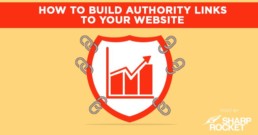
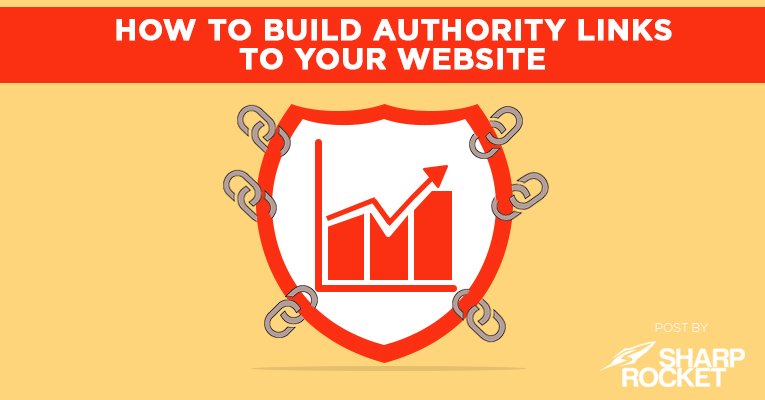
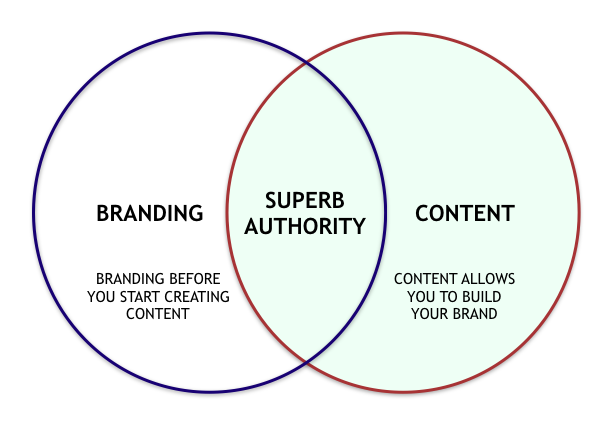
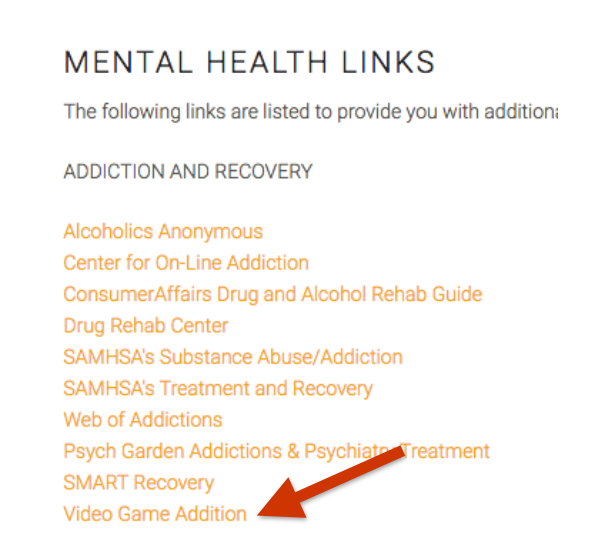 B. Reverse engineer new content assets with highest link growth
B. Reverse engineer new content assets with highest link growth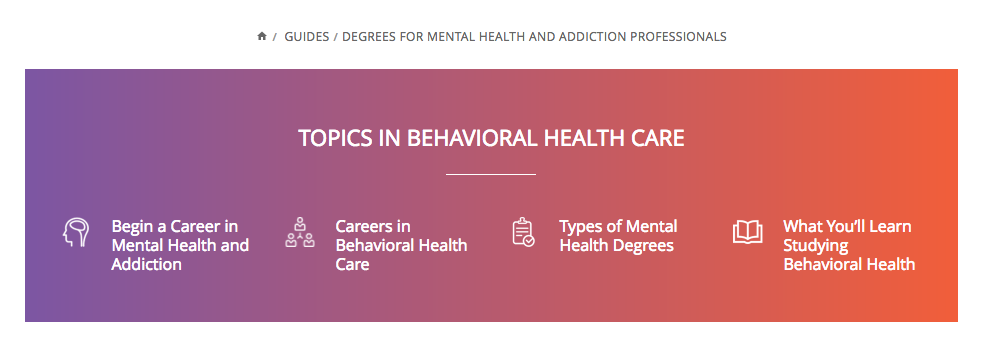 4.
4. 